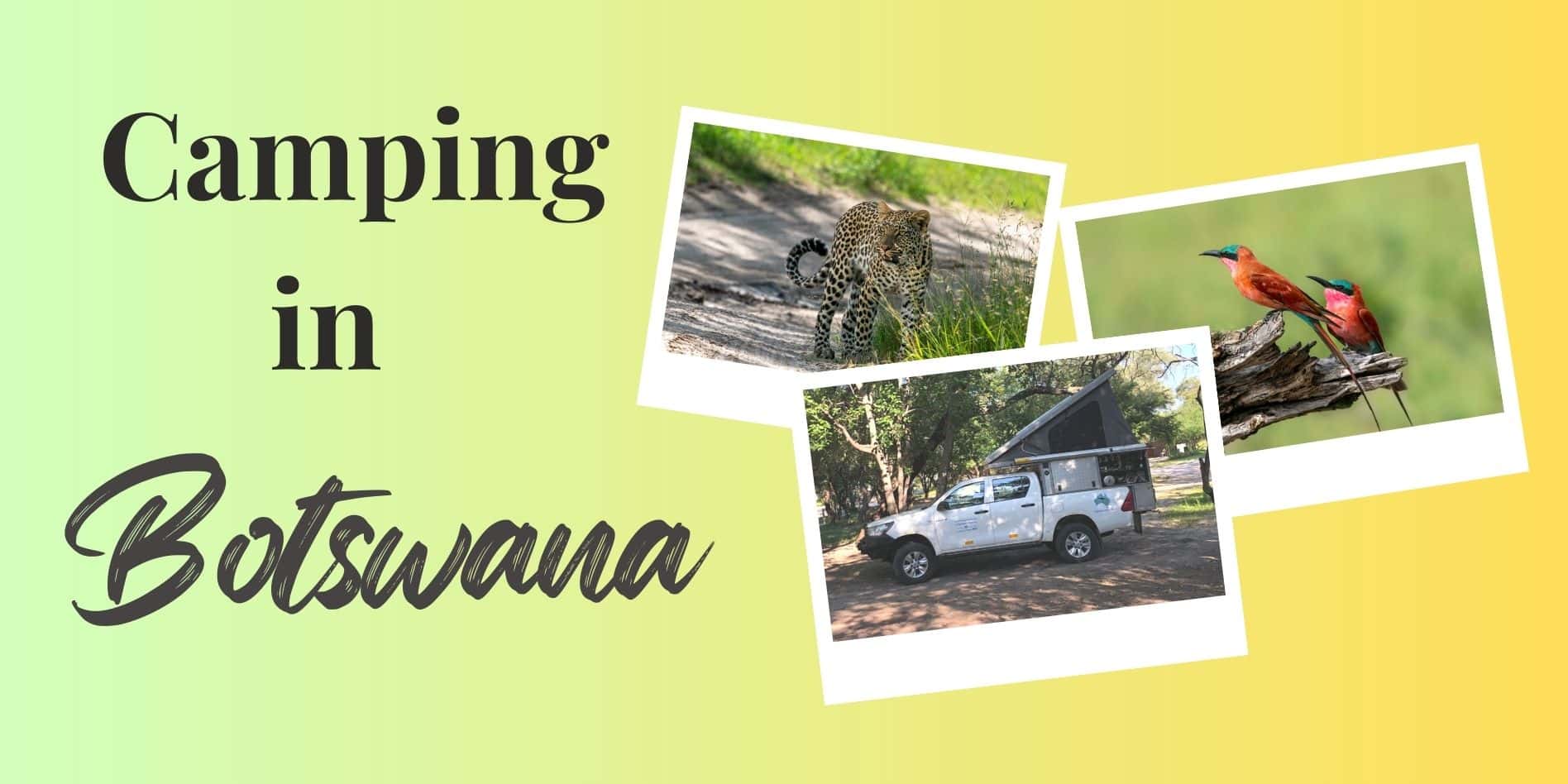If you are planning a Botswana camping safari, this guide will help you explore the magnificent destinations and parks that the country offers and provide valuable information that you need to know before camping in Botswana.
As part of our overland road trip travels in Africa, we camped throughout Botswana for about two months. In fact, our 4×4 Hilux with a pop-up tent is stored in Maun (the gateway to the UNESCO-listed Okavango Delta) in Botswana, awaiting our return.
🏆 If you are looking for somewhere to stay in Maun, Maun Studios or Acacia Cottage are by far the best options, and we’ve stayed in both several times.
🐘 What’s Included in this Camping in Botswana Post?
Jump ahead to any of the links below or browse through everything you need to know for your camping trip in Botswana.
- ⛺️ Why Camping is the Best Way to Explore Botswana
- 👀 Quick Look at the Top Botswana Camping Safaris
- 📋 Planning your Botswana Camping Trip & Helpful Checklists
- 🥾 Packing Essentials
- 🏕️ Best Camping Sites in Botswana
- 📋 Botswana Permits
- 🚙 Renting a 4×4 in Botswana
- 🔦 Essential Botswana Camping Equipment
- 🦺 Camping in Botswana Safety Tips
- 🌦️ Best Time for Safari Camping in Botswana
- 🛶 Botswana Camping Activities
- ↪️ Getting to Botswana
- ❓ FAQs

Map: Camping in Botswana
This Botswana Camping map includes all the destinations and camping spots mentioned in this article.
Camping in Botswana Guide: Our Best Advice and Tips
In this comprehensive Botswana guide to camping, you’ll discover valuable tips and essential information on camping and the best camps in Botswana.
These include:
- Planning your Botswana camping safari
- Choosing the best campsites in Botswana (we’ve camped in all of the listed National Parks)
- The wildlife you may encounter along the way
For a detailed look at where to stay and campsites, head over to our Botswana self-drive safari Itinerary.
Botswana is one of the best places for an African safari adventure.
Welcome to the Wilderness!
💡 Our Tip: Book well ahead to ensure you can get the campsite you want – especially if you will be travelling in the peak season.
Planning a Trip to Botswana?
- 🚗 Hiring a car? We recommend getting a quote from DiscoverCars
- 🚐 Hiring a campervan? We recommend Motorhome Republic
- ⛑ Arranged your travel insurance? Compare quotes from World Nomads & Safetywing
- 🪪 Order your International Driver’s Licence online here
- 🏩 Booked your accommodation? We use Booking.com to find the best deals
- 🐾 Is someone pet-sitting for you? 🐾 We use and love TrustedHousesitters
- (Get 25% off at checkout for new memberships with our discount code: LIFEJOURNEY25)

1. Why Camping is the Best Way to Experience the Beauty of Botswana
While we were overlanding in Botswana, we found that while many tourists still opt for traditional guide safari experiences, there is a growing trend among nature lovers to explore Botswana through camping.
We met many campers who had hired 4x4s with rooftop tents and loved the wild adventure camping in Botswana provides, such as camping in National Parks and in remote areas. Most came from Europe, with some from the US and Australia and were mainly on a three or four-week trip.
A self-drive safari in Botswana, with a hired camper, is also a more budget-friendly way of travelling and experiencing a Botswana safari compared to staying in luxury camps on an organised tour.
🚐 Thinking of Hiring a 4×4 Camper in Botswana?
We’ve used, and recommend using, Motorhome Republic to find you the best deal – they search all the local, reputable rental companies in Botswana, including Avis Safari, Britz and Caprivi Car Hire.
They do all the hard work for you, and they have a PRICE BEAT GUARANTEE
For us, a Botswana self-drive safari provides a unique opportunity to immerse ourselves in the wilderness, and we feel we have a more authentic and intimate connection with nature.
Whether it’s falling asleep to the symphony of barking geckos in the desert, or tree frogs by the rivers, or waking to the explosion of colour from the sunrise over vast swathes of golden grass in the savannahs, camping in Botswana, national parks offers a satisfying way to appreciate the raw splendour of this country fully.
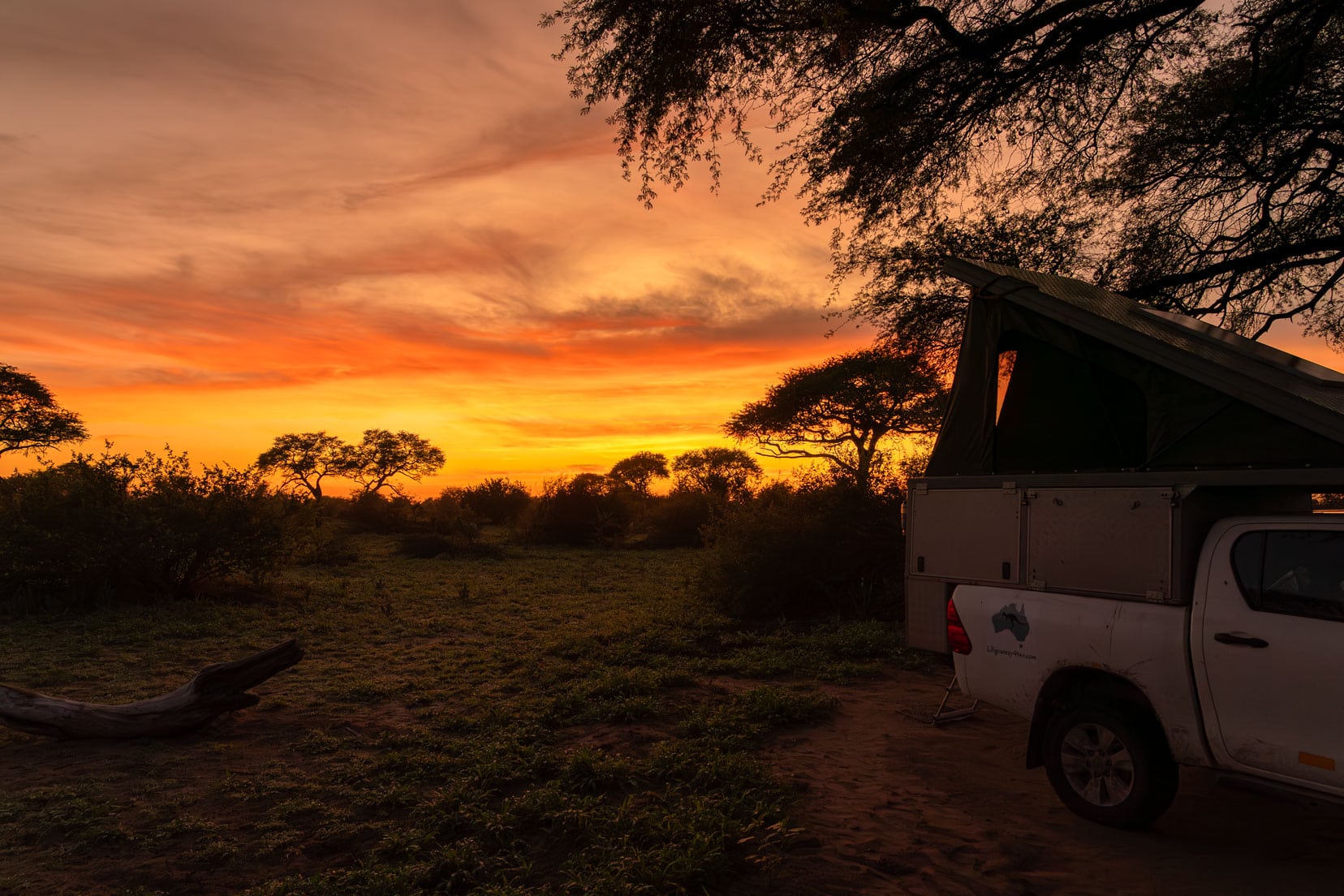
2. Quick Look at Some of the Top Botswana Camping Safaris
If you prefer to book a guided safari rather than embark on your own self-drive itinerary through Botswana, then these are some of the top-rated Botswana Safaris:
- 🐘 Chobe / Moremi: 9-Day Authentic Mobile Tented Safari in Chobe National Park and Moremi Game Reserve, Botswana | Find out more here |
- 🦛 Moremi Game Reserve – Khwai: 5-Day Moremi Wildlife Camping and Hippo Safari in Botswana | Find out more here |
- 🐆 Okavango Delta Mokoro: 3 Day Mokoro Safari in the Okavango Delta | Find out more here
3. Planning Your Botswana Camping Trip
If you’re new to the concept of camping safaris or are planning a camping trip to Botswana, this comprehensive guide is here to help.
So, let’s start right back at the planning stage with everything you’ll need to consider.
Botswana Camping Planning Checklist
- ☑️ Allow enough time for a leisurely trip – you want to have time to enjoy your experience.
- ☑️ Create a realistic budget, considering all expenses, such as flights to Botswana, rental car hire, fuel, food, campsite fees, National park fees, and any optional additional tours.
- ☑️ Make a rough list of destinations and attractions (See our list of best safari campsites below)
- ☑️ Research destinations and update your itinerary
- ☑️ Find a 4×4 vehicle with a rooftop tent to hire
- ☑️ Plan daily driving hours and campsite locations
- ☑️ Prepare for border crossings and fresh produce regulations
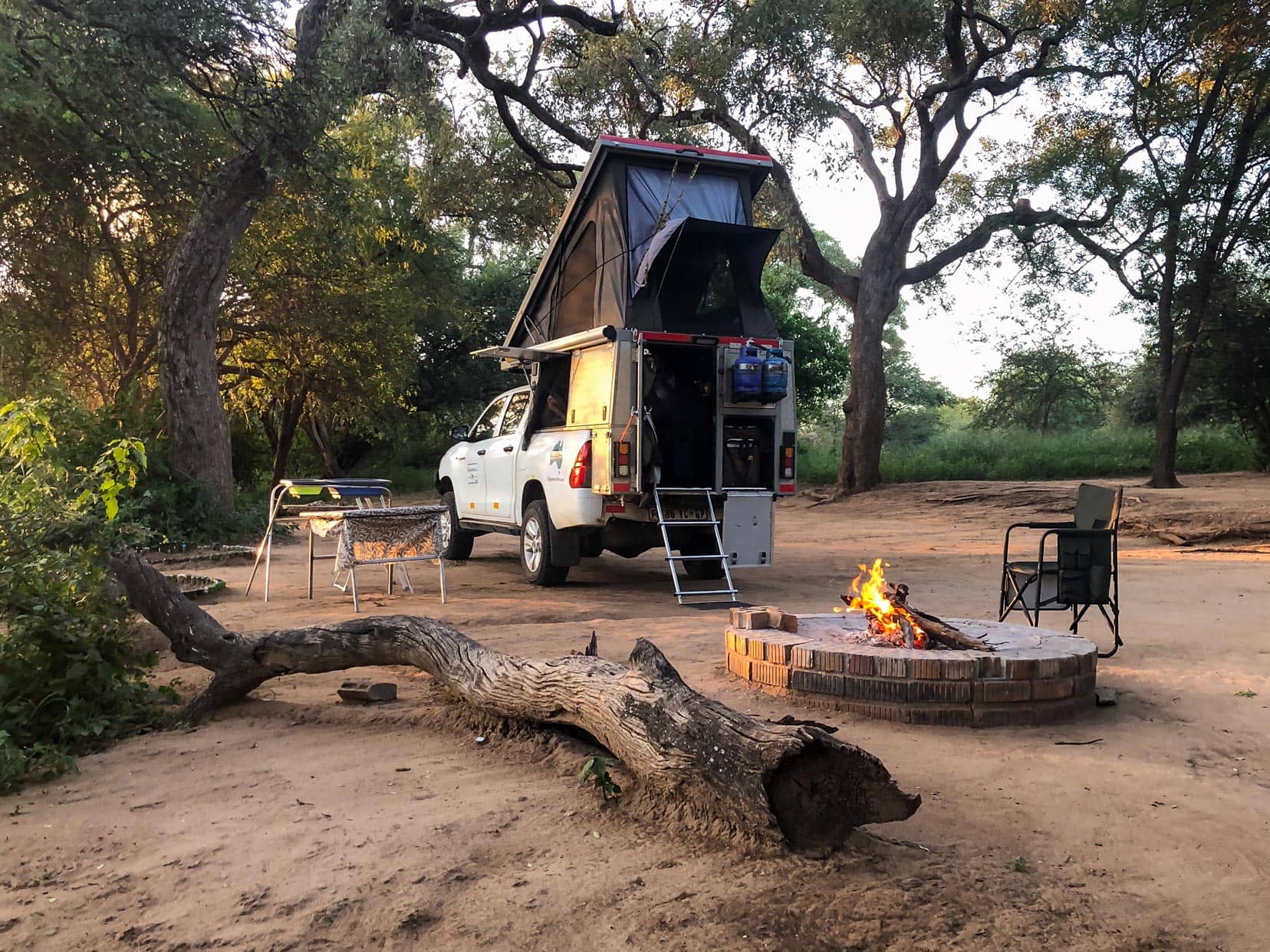
Paperwork Checklist
- ◻️ Valid passport with at least six months remaining
- ◻️ Arrange Travel Insurance: Compare quotes from our favourites: World Nomads & Safetywing
- ◻️ Botswana Visa (If required)
- ◻️ International driver’s license
- ◻️ Border crossing documents (if crossing a border)
- ◻️ Accommodation and campsite confirmations/vouchers
- ◻️ Certified copies of important documents
- ◻️ Digital copies of documents uploaded to a secure online server
▶︎ Have you got your International Drivers Licence for Botswana organised yet? Apply Easily online here.
Medical Checklist
- ◻️ Make sure you have enough of your normal prescription medicine to last the trip or a letter from your doctor advising the medications you are on so you can more easily get a prescription for them while in Botswana.
- ◻️ Required vaccinations, such as Hepatitis A; Poliomyelitis; Tetanus, Hepatitis B; Rabies; Typhoid.
- ◻️ Yellow fever vaccination certificate is required for travellers aged one year or over arriving from or having transited through a country with a risk of yellow fever transmission.
- ◻️ Malaria prophylaxis
- ◻️ Well-stocked first aid kit
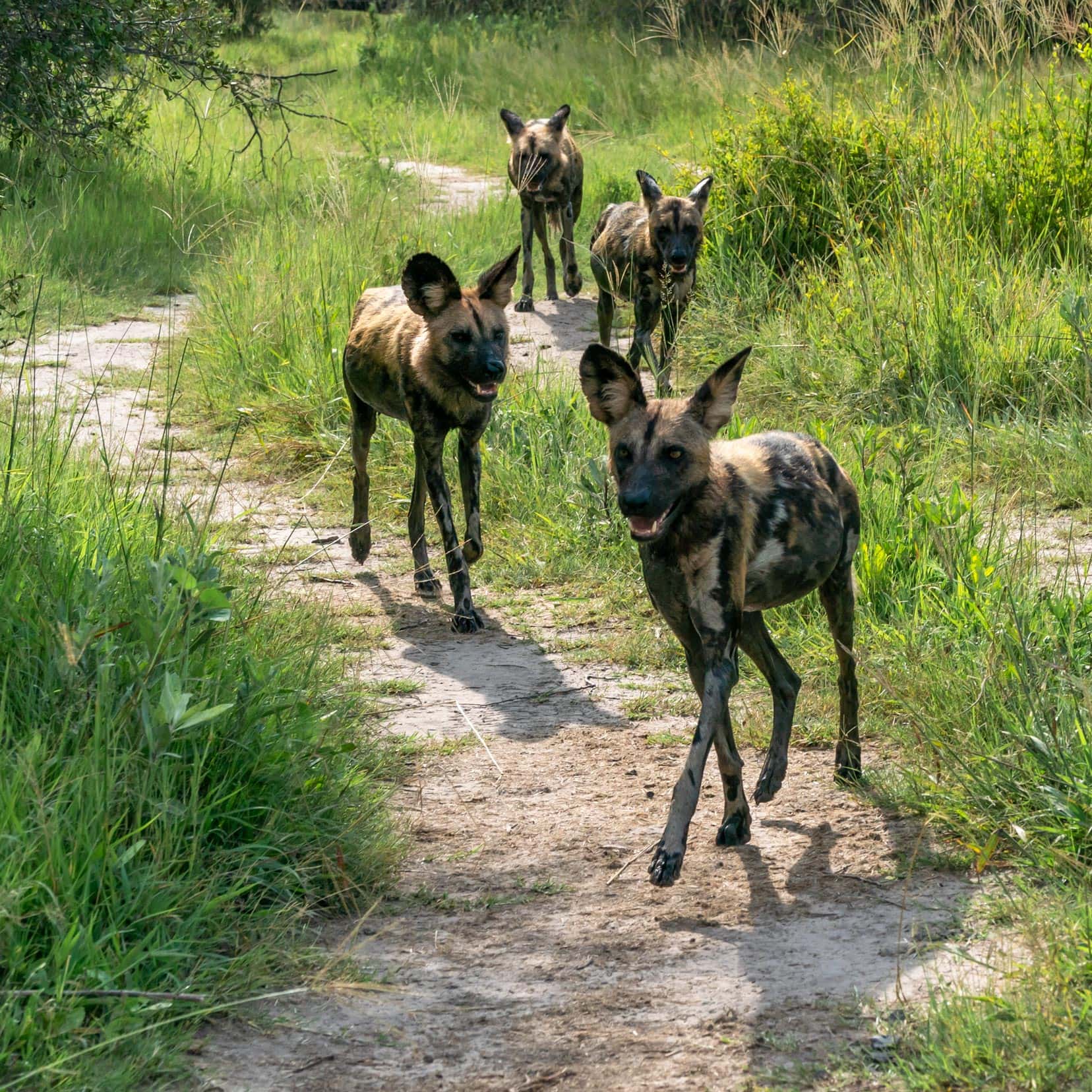
4. Botswana Camping Packing Essentials
We list the items you’ll need for your vehicle and general camping equipment further on, but before you embark on your trip, it’s a good idea to check that you have thought about what to pack for your safari.
Some of the essential safari accessories include;
- Binoculars
- Camera
- Sunglasses,
- Neutral colour clothing
- Sunhat
- Sunscreen
- Mosquito repellent
If you are a keen photographer, consider what photography gear you’ll take camping. Making sure you have the right combination of lenses whilst at the same time considering the extra weight is no easy task.

5. Botswana National Park Campsites – Best Camping Sites
From the vast expanses of the lush Okavango Delta to the salt pans of Nxai Pan and the Kalahari Desert, the National Parks of Botswana offer unique experiences and thrilling encounters with the wild.
And we’ve camped in all of them.
There are numerous Botswana camping sites: national park campsites, community-run campsites, private campsites, luxury campsites and wild camping areas in Botswana. (By wild camping, I mean camping in the wilderness rather than camping outside of a camp, which is illegal in Botswana).
As you can see, when you’re planning to go camping in Botswana, you have several camping options to choose from.
In this article, we cover the main National Parks with a variety of wilderness camping options, from the most basic with no facilities to those with fully equipped ablutions with showers and flushable toilets.
These include:
- Chobe National Park
- Moremi National Park
- Okavango Delta
- Khwai Concession
- Nxai Pan
- Makgadikgadi Pans National Park
- Central Kalahari Game Reserve
- Kgalagadi Transfrontier National Park
- Khama Rhino Sanctuary
💡If you are staying in a campsite run by the DWNP, paying the National Park permit fees beforehand is best, as the Parks and Reserves only take cash at the gate for the permit. You must also show your camping site reservation voucher when entering the parks.
Chobe National Park
Nestled along the Chobe River, Chobe National Park in Northern Botswana is renowned for its abundant wildlife and diverse landscapes. As you pitch your tent under the starlit sky, you’ll be surrounded by the sounds of nature, with the distant calls of elephants and hippos grunting in the river.
Campsites and Facilities
With basic campsites equipped with shared ablutions, camping in Chobe National Park is a fantastic way to immerse yourself in nature, making memories that will last a lifetime.
Chobe National Park has two campsites where you can book a spot to enjoy the wilderness and wildlife.
- Ihaha Campsite: Situated along the Chobe River, Ihaha offers stunning riverfront views but has only basic facilities such as ablution blocks and fire pits. When we were there, the camp was having problems with break-ins.
We were told that the police were patrolling the camp at night – but we didn’t see any while we were there. - Savuti Campsite: Located in the Savuti region of the park, this campsite is renowned for its predator sightings, including lions and hyenas.
It has shared ablutions with showers, flush toilets, and a tap and fire pit at each campsite. The proximity to wildlife-rich areas makes it a favoured choice for nature enthusiasts.
Camping in Chobe National Park can work out expensive, and although it’s great to experience the wildness of camping in the park, it can be cheaper to stay outside the park and drive in for daily visits.
We also stayed at the following two campsites outside of Chobe:
Kubu Lodge: This lodge is only a 10/15 minute drive away from the entrance to Chobe National Park. The campsite has 22 sites and a shared ablution block with hot showers and flush toilets. There is electric power, water tap and braii area at each site.
Be prepared for hippos to come into camp in the nighttime and bushbuck, warthog and banded mongoose to come investigating in the day. We saw all of these while we were there.

Senyati Safari Campsite: Located outside the park boundaries, this private campsite is a great option for those seeking better camping facilities. Each campsite has its own ablutions, and there is a bar, restaurant, swimming pool, and a viewing deck overlooking a waterhole regularly visited by elephants.
Remember that camping in Chobe National Park requires advance booking, and it’s essential to check availability and make reservations in advance, especially during peak seasons.
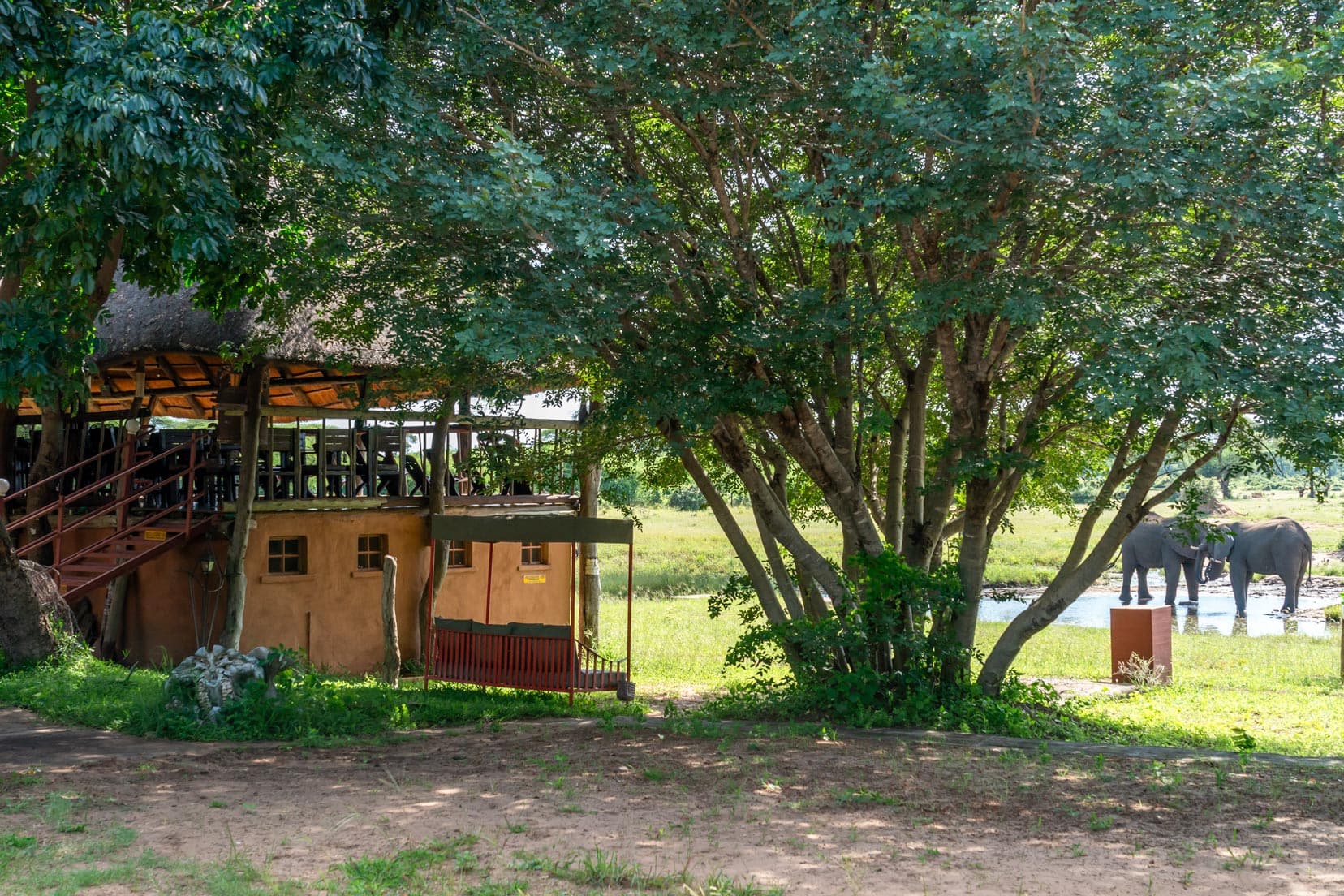
Wildlife Viewing in Chobe
We visited Chobe both in the summer and the start of winter, and both times, we didn’t see as much as we expected to, given the hype of others who’d visited.
It is a classic example of having luck on your side while on a safari.
Especially a self-drive safari.
💡 Our Tip: If you only have a short time in Botswana and can afford it, an organised tour will maximise your sightings and improve your chances of seeing a wider variety of wildlife. This is particularly so for those of you interested in wildlife photography.
We love our slow travel through Africa in our camper but appreciate that not everyone has the luxury of taking the slow road. To maximise your photo safari, you may want to organise a tour.
On our summer visit, it was raining much of the time while we were there, which is never a great time to be spotting wildlife. In winter, although the vegetation was more sparse, luck again wasn’t on our side.
What was fantastic in Chobe, though, and several people had told us to do, was joining a sunset cruise on the river. Watching the elephants frolicking in the river was an absolute highlight of our Chobe trip.
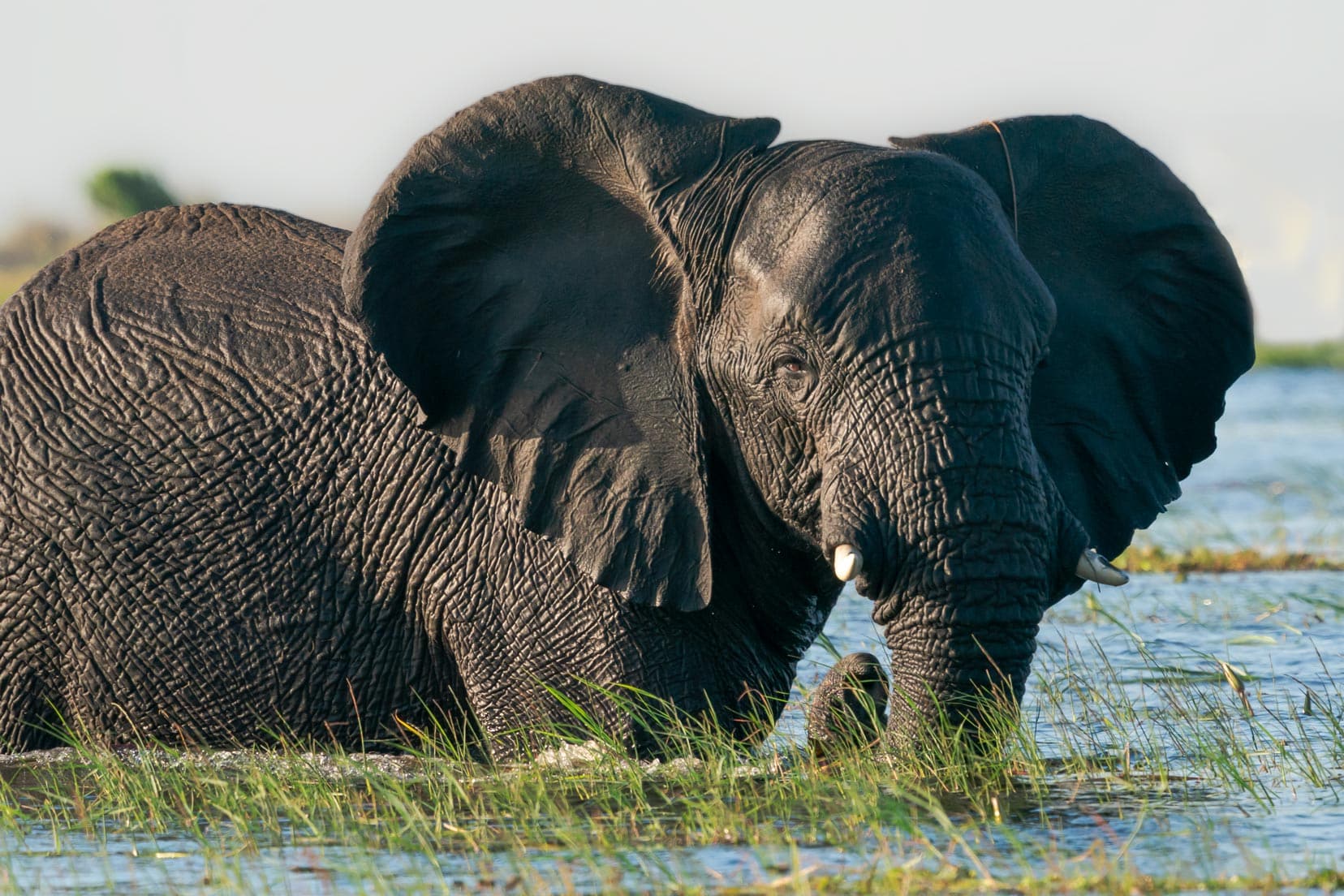
Likely to see in Chobe
- Elephants ✅
- Buffalo ✅
- Hippos ✅
- Impala ✅
- Baboon ✅
- Vervet Monkey ✅
- Steenbok ✅
- Kudu ✅
- Waterbuck ✅
- Giraffe ✅
- Zebra ✅
- Black-backed jackal ✅
- Blue wildebeest ✅
- Warthog ✅
- Mongoose ✅
If You’re Lucky in Chobe
- Cheetah ✅
- Leopard ✅
- Lion ✅
- African Wild dogs
- Black rhino
- White Rhino
- Honey Badger
- Spotted hyena
- Side striped jackal
The green ticks show the animals we saw while we were camping or visiting Chobe National Park.
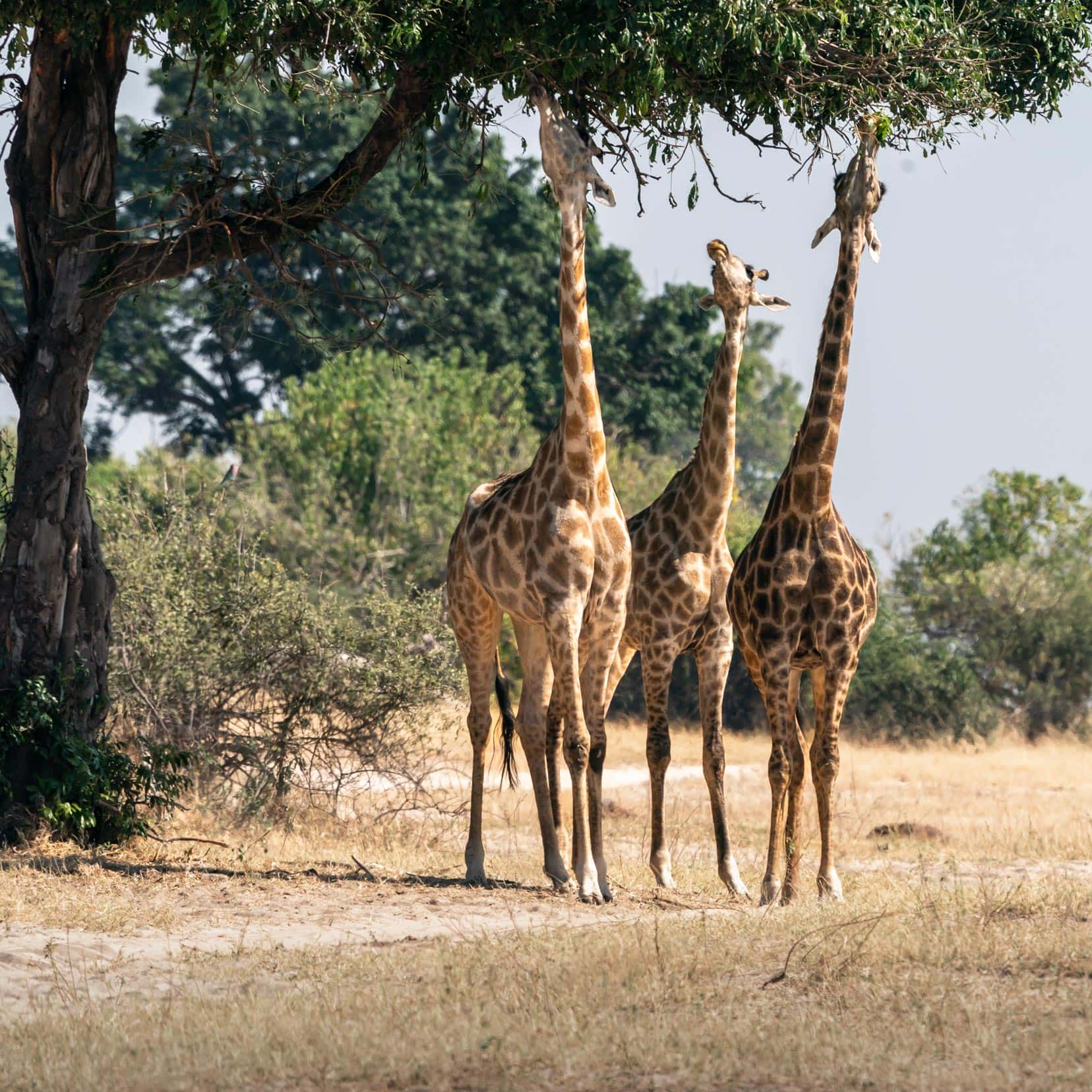
Moremi Game Reserve
Camping in Moremi Game Reserve offers a truly immersive experience in the heart of the Okavango Delta.
As one of Botswana’s most renowned national parks, camping here allows you to be surrounded by diverse and abundant African wildlife, including elephants, lions, hippos, and an array of bird species.
Campsites and Facilities
Moremi Game Reserve has four main public rest camps:
- South Gate Camp
- Third Bridge Camp
- Xakanaxa Camp
- North Gate (Khwai) Camp
These four public Moremi campsites are bookable through private operators: Xomae Sites, Kwalate Safaris and SKL camps. Each camp only has ten campsites, so they can get booked out quickly in the peak season.
All of the Moremi rest camps have basic facilities such as a water tap, campfire pits, and shared ablution blocks with showers and flushable toilets. The water is heated by solar – but even though we were there in summer, most of the time, the showers were cold.
There isn’t any electricity, lighting or network signal at any of the rest camps.
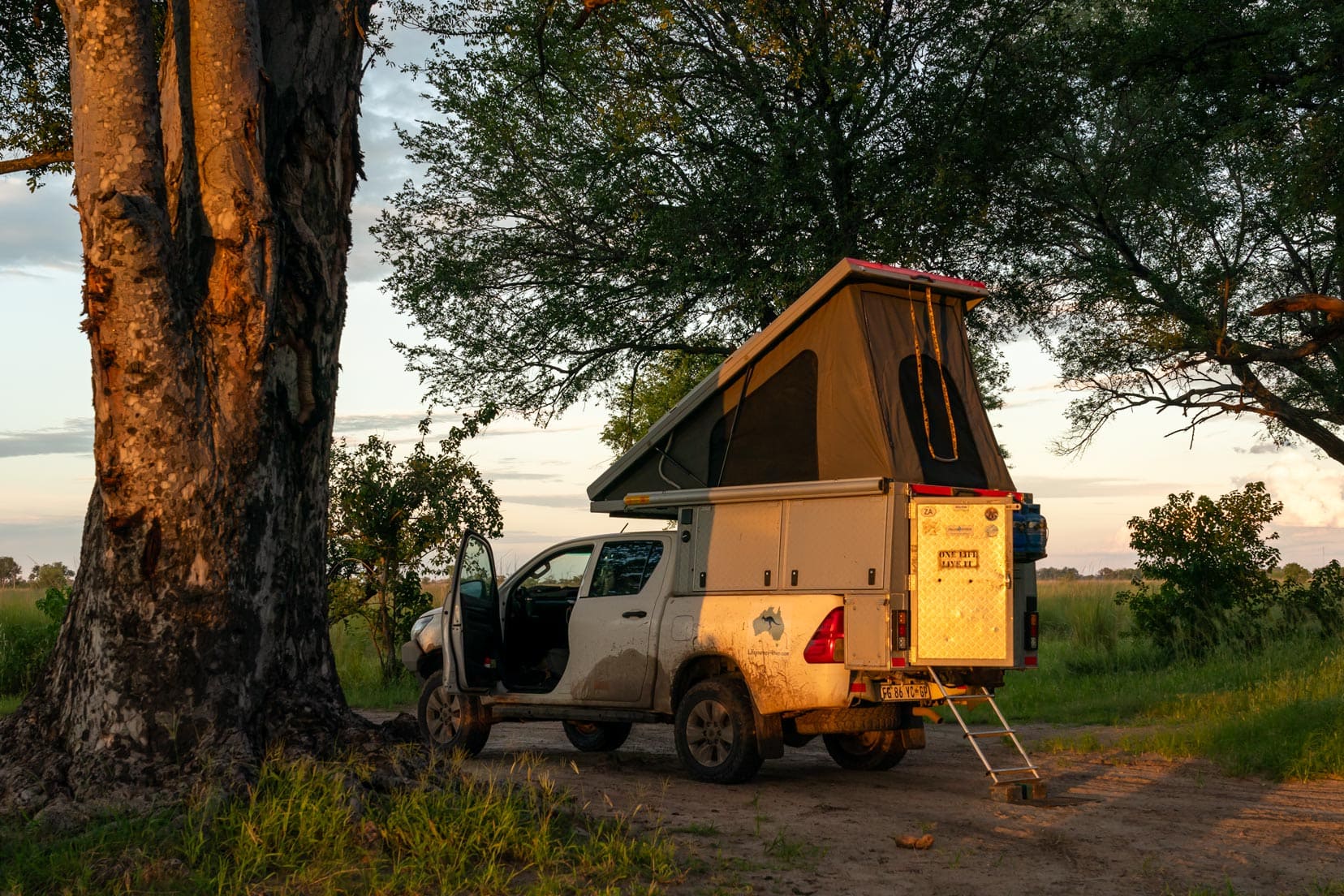
Wildlife Viewing in Moremi
The reserve is home to a wide variety of wildlife, including elephants, lions, leopards, giraffes, buffalos, and over 400 different bird species.
As with any wildlife viewing, you can never be guaranteed a sighting, but these lists will give some idea of the animals you may encounter on a camping safari in Moremi Game Reserve.
The green ticks show the animals we saw while we were camping in Moremi Game Reserve.
Likely to see in Moremi
- Red Lechwe ✅
- Impala ✅
- Baboon ✅
- Vervet Monkey ✅
- Steenbok ✅
- Kudu ✅
- Waterbuck ✅
- Giraffe ✅
- Zebra ✅
- Elephant ✅
- Hippos ✅
- Black-backed jackal ✅
- Buffalo ✅
- Blue wildebeest ✅
- Warthog ✅
- Red hartebeest ✅
- Mongoose ✅
If You’re Lucky in Moremi
- Cheetah ✅
- Leopard ✅
- Lion ✅
- African Wild dogs
- Black rhino
- White Rhino
- Honey Badger
- Spotted hyena
- Side striped jackal
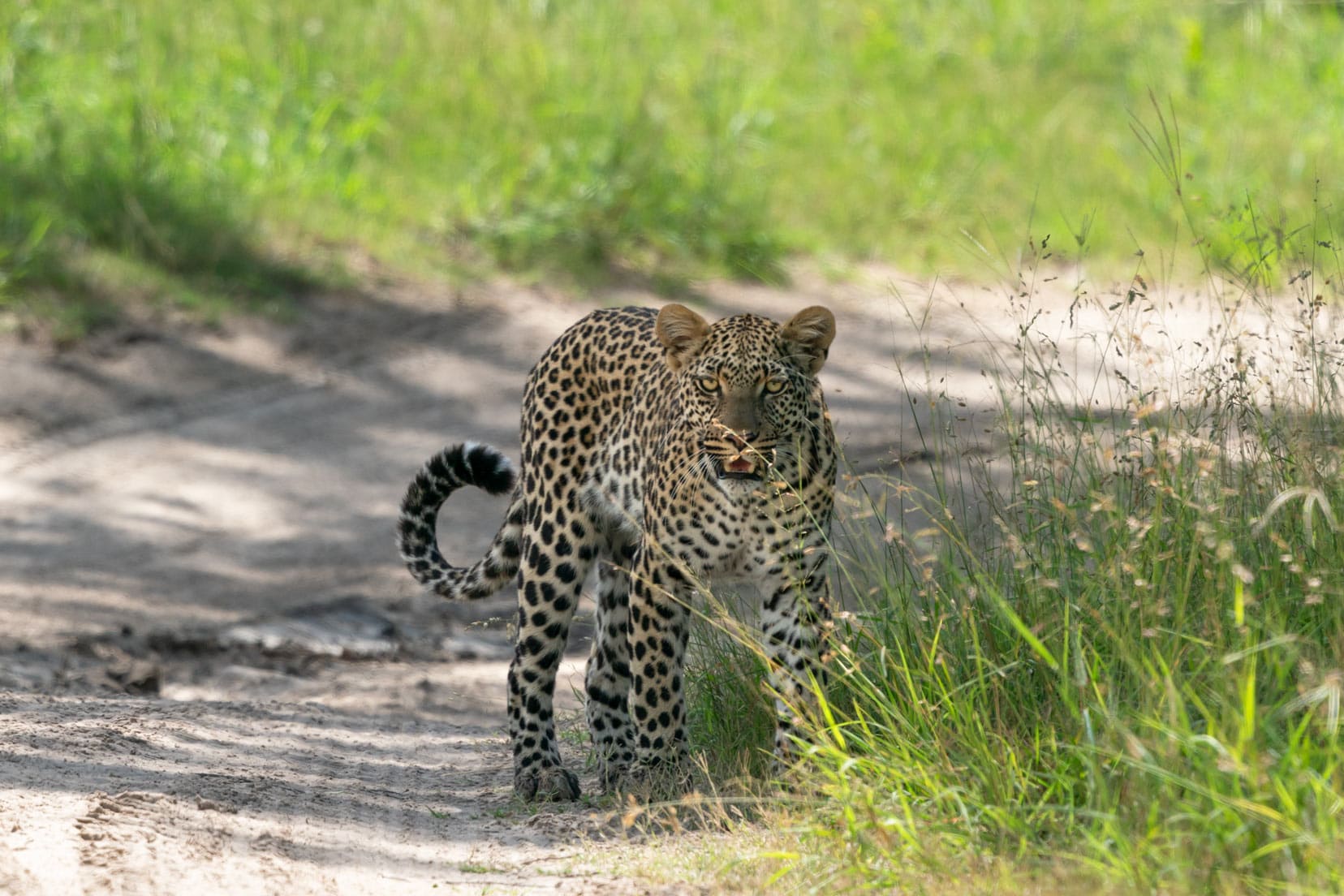
Okavango Delta
From setting up camp amidst the wilderness to embarking on thrilling Botswana safari game drives and mokoro trips, camping in the Okavango Delta promises an unforgettable adventure in one of Africa’s most iconic destinations.
Okavango Campsites and Facilities
When planning a camping trip in the Okavango Delta, you can choose from booking a mobile safari trip through a tour operator, staying in luxury tented camps, or camping in your own tent or vehicle.
The Moremi Game Reserve, run by the Department of Wildlife and National Parks (DWNP), offers several public rest camps with limited campsites that need to be booked in advance.
Best Glamping Botswana – Okavango
For a more luxurious experience, exclusive camps like Chiefs Camp are accessible only by air. Whichever option you choose, ensuring your vehicle is well-equipped for the challenging terrain and carrying all the necessary camping gear and supplies is crucial.
| Okavango Camps/Lodges | Best for | Rating | Book |
| Camp Okavango | 👨👩👧👦. Couples and families | 4.9/5 | Book Here |
| Chief’s Camp | 👫 Couples and children 6+ | 4.9/5 | Book Here |
| Mombo Camp | 👫 Couples / 📸 Wildlife photographers | 4.9/5 | Book Here |
Wildlife Viewing in the Okavango Delta
The Okavango Delta is renowned for its diverse ecosystem and abundant wildlife, with the delta’s network of channels, lagoons, islands, and floodplains supporting a wide variety of animals.
These include elephants, lions, leopards, cheetahs, hyenas, hippos, crocodiles, and various antelope species. It is also a vital refuge for endangered species like the African wild dog and the Sitatunga antelope.
The green ticks below show the animals we saw while we were camping in the Okavango Delta.
Likely to see (Okavango)
- Red Lechwe ✅
- Impala ✅
- Baboon ✅
- Vervet Monkey ✅
- Steenbok ✅
- Kudu ✅
- Waterbuck ✅
- Giraffe ✅
- Zebra ✅
- Elephant ✅
- Hippos ✅
- Black-backed jackal ✅
- Buffalo ✅
- Blue wildebeest ✅
- Warthog ✅
- Red hartebeest ✅
- Mongoose ✅
- Crocodile ✅
- Kori Bustard ✅
- Secretary bird ✅
If You’re Lucky (Okavango)
- Cheetah ✅
- Leopard ✅
- Lion ✅
- Rare Pel’s fishing owl
- Rare sitatunga
- African Wild Dogs ✅
- Black rhino
- White Rhino
- Honey Badger
- Spotted hyena
- Side striped jackal
Khwai Community Concession
During our unforgettable journey through the Khwai Concession, we had the opportunity to immerse ourselves in the heart of the wilderness at Magotho Camp.
This campsite, managed by the local Khwai community, offered us a unique and authentic experience with fabulous sightings of elephants in the river and wild dogs prancing through the savannah grasses.
Campsites and Facilities
While there are various campsites available in the area, we were drawn to the charm of Magotho Camp in the Khwai Concession for several reasons.
Firstly, by choosing this community concession camp, we knew that our camp fees would directly contribute to supporting the local Khwai community, helping them preserve their culture and conserve the surrounding wildlife.
Moreover, Magotho Camp offered a distinct advantage over other camps in terms of flexibility. Unlike many other locations, Magotho Camp had more relaxed rules and regulations, allowing us to fully embrace the freedom of the wilderness.
The campsites are well spaced out amongst the camelthorn trees with a firepit. There are a few basic ablution tents around the campsite with showers and flush toilets.
Wildlife Viewing in Khwai
The green ticks below show the animals we saw while we were camping in the Khwai Concession.
Likely to see in Khwai
- Hippo ✅
- Elephant ✅
- Red Lechwe ✅
- Waterbuck ✅
- Crocodiles ✅
- Impala ✅
- Kudu✅
- Zebra ✅
- Giraffe ✅
- Kori Bustard ✅
- Secretary bird ✅
If You’re Lucky in Khwai
- Wild dogs ✅
- Lion
- Cheetah
- Leopard
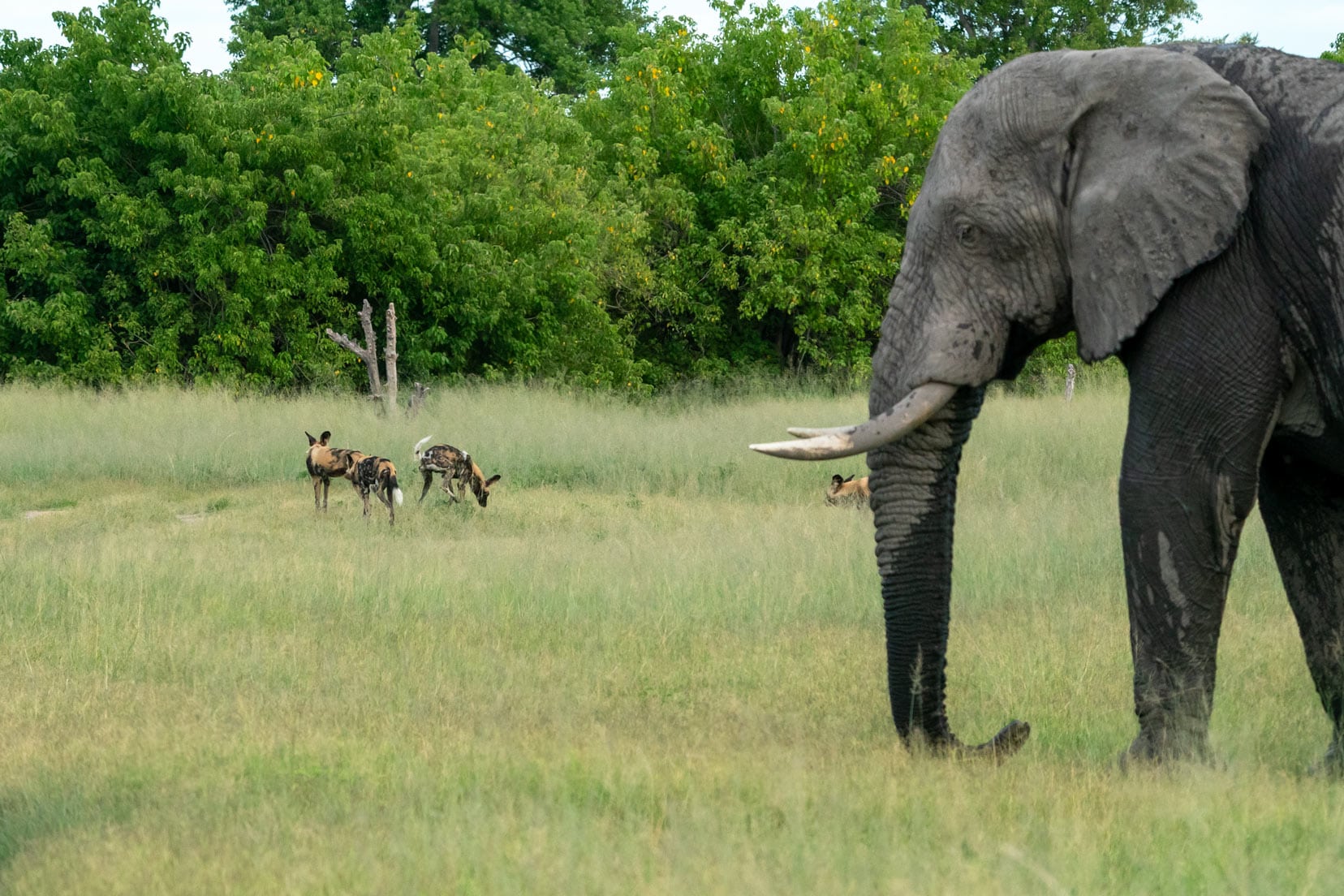
Nxai Pan
Nxai Pan offers a unique camping experience surrounded by vast salt pans and ancient baobab trees, and depending on when you visit – you can witness one of the largest zebra migrations in Africa.
Campsites and Facilities
There are two campsites at Nxai Pan National Park. The main camp is South Camp, which is the best for wildlife spotting. The second is at Baines Baobabs, next to the Kudiakam Pan, with three camp spots set amongst ancient baobab trees.
There are 10 camping spots at Nxai Pan South Camp, which is operated by Xomae Camps.
Most are under shady trees, each with a firepit and access to two shared ablution blocks. The toilets and showers were clean and well-kept. Though there wasn’t any hot water when we were there in summer.
We stayed at Campsite 2, which is right near the edge of the pan and has the best views.
Sitting in camp, we watched herds of zebra and wildebeest grazing on the summer pan, and the odd giraffe and elephant wandered by.
In the evening, the black-backed jackals sneaked through, looking for scraps.
Wildlife Viewing in Nxai Pan
Driving around, we saw hundreds of zebras, as well as wildebeest, giraffes, elephants, springbok, impala, black-backed jackals, a bat-eared fox, steenbok, and plenty of birdlife.
We saw our first southern carmine bee-eater, a violet-eared waxbill and a grey-headed kingfisher– all colourful birds that we’ve been on the lookout for throughout South Africa and Botswana.
The green ticks below show the animals we saw while we were camping in Nxai Pan.
Likely to see in Nxai Pan
- Elephant ✅
- Zebra ✅
- Giraffe ✅
- Impala ✅
- Wildebeest ✅
- Springbok ✅
- Steenbok ✅
- Black-backed Jackals ✅
- Kori Bustard ✅
- Secretary bird ✅
If You’re Lucky in Nxai Pan
- Wild dogs ✅
- Bat-eared Fox ✅
- Lion
- Cheetah
- Leopard
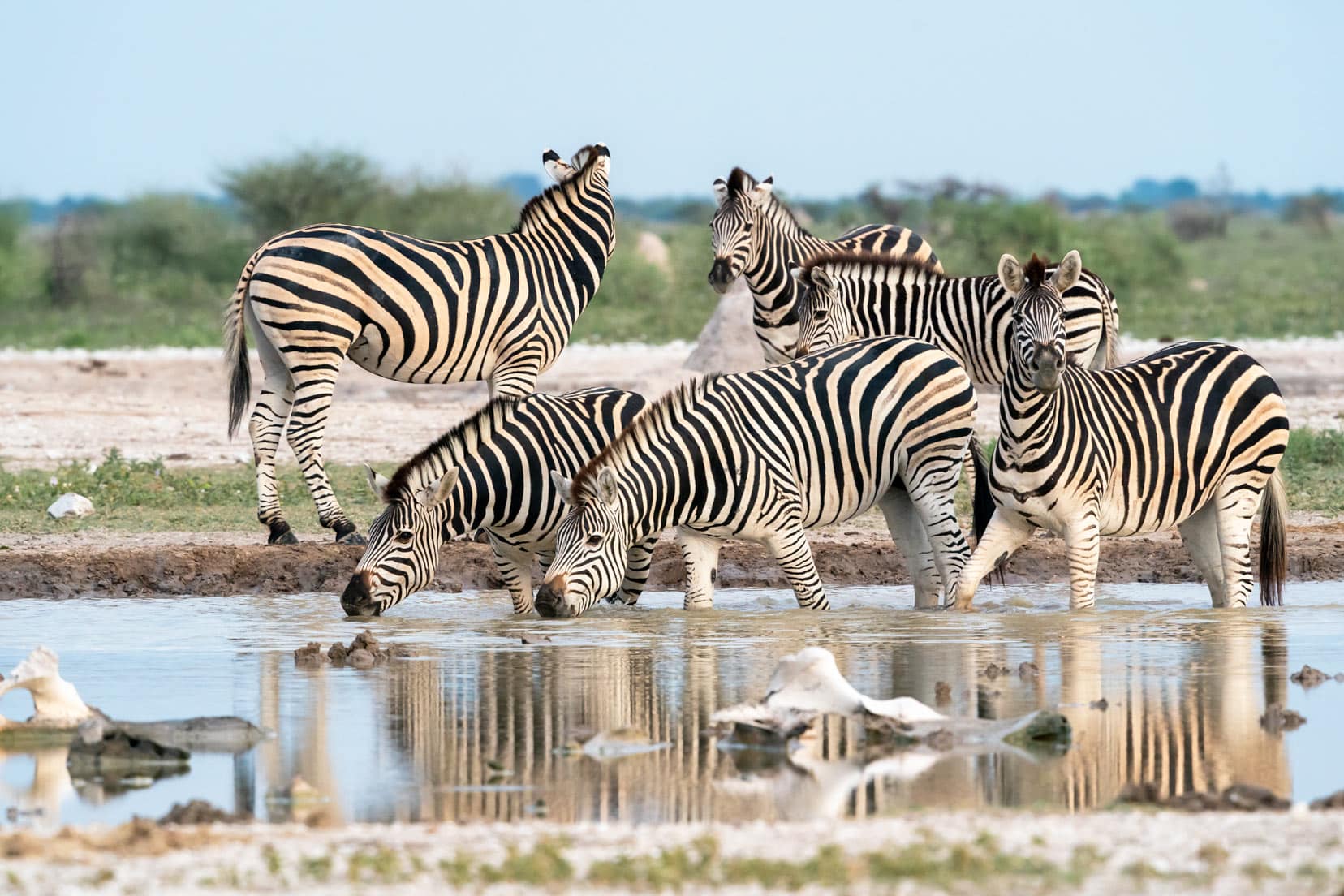
Makgadigadi Pans National Park
Makgadikgadi Pans National Park is located in the central-eastern area of Botswana in Southern Africa. The park is part of the Makgadikgadi Salt Pans area, which has the largest salt pans in the world and is on the UNESCO Tentative List.
Campsites and Facilities
We stayed at Khumaga campsite in Makgadikgadi, which consists of 10 pitches and two ablution blocks, which were clean and well looked after while we were there. Each site had a rubbish bin and a fire pit.
The sites also have bore water, but we were told it wasn’t suitable for either drinking or cooking. Therefore, make sure you have enough water for your trip (and extra in case of emergency).
The camp is run by SKL Camps: [email protected]
Wildlife Viewing in Makgadikgadi
The green ticks below show the animals we saw while we were camping in Makgadikgadi.
Likely to see (Makgadikgadi)
- Zebra ✅
- Wildebeest ✅
- Hippo ✅
- Springbok ✅
- Impala ✅
- Gemsbok/oryx ✅
- Wildebeest ✅
- Kudu ✅
- Elephant ✅
- Steenbok ✅
- Giraffe ✅
- Black-backed jackals ✅
- Crocodile ✅
- Kori Bustard ✅
- Secretary bird ✅
- Northern black korhaan ✅
- Ostrich ✅
- White-backed Vulture ✅
If You’re Lucky (Makgadikgadi)
- Cheetah
- Lion
- Leopard
- Wild dogs
- Eland
- Honey badger
- Brown hyena
- Aardwolf
- Bat-eared foxes
- Red hartebeest

Central Kalahari Game Reserve
Botswana’s Central Kalahari Game Reserve (CKGR) is the largest reserve in Southern Africa and the second largest in the world. It’s made up of thousands of kilometres of arid savannah, red sand dunes, fossilised (dry) river valleys, clay pans, scrub bushes and low-lying trees.
Campsites and Facilities
The northern part of the Central Kalahari Reserve is the best for camping and exploring. Most of the campsites are located here, where most wildlife is seen.
The most popular are Deception Valley, Piper Pan and Sunday Pan. We stayed at Piper Pan and Sunday Pan, with both campsites only having drop toilets and a bucket shower.
Many of the campsites are bookable through Bigfoot Tours (including Piper Pan and Sunday Pan), and some of the others through Botswana Parks and Wildlife (DWNP).
Wildlife Viewing in CKGR
The green ticks below show the animals we saw while we were camping in the Central Kalahari Game Reserve.
Likely to see (CKGR)
- Springbok ✅
- Gemsbok ✅
- Wildebeest ✅
- Steenbok ✅
- Black-backed jackals ✅
- Bat-eared foxes ✅
- Kori Bustard ✅
- Secretary bird ✅
- Northern black korhaan ✅
- Ostrich ✅
- Cape ground squirrels ✅
If You’re Lucky (CKGR)
- Cheetah
- Leopard
- Lion ✅
- Black-maned lion
- Wild dogs
- Giraffe ✅
- Red hartebeest
- Eland
- Elephant ✅
- Mongoose ✅
- Zebra
- Honey badger
- Brown hyena
- Lapped-faced Vulture
- White-backed Vulture
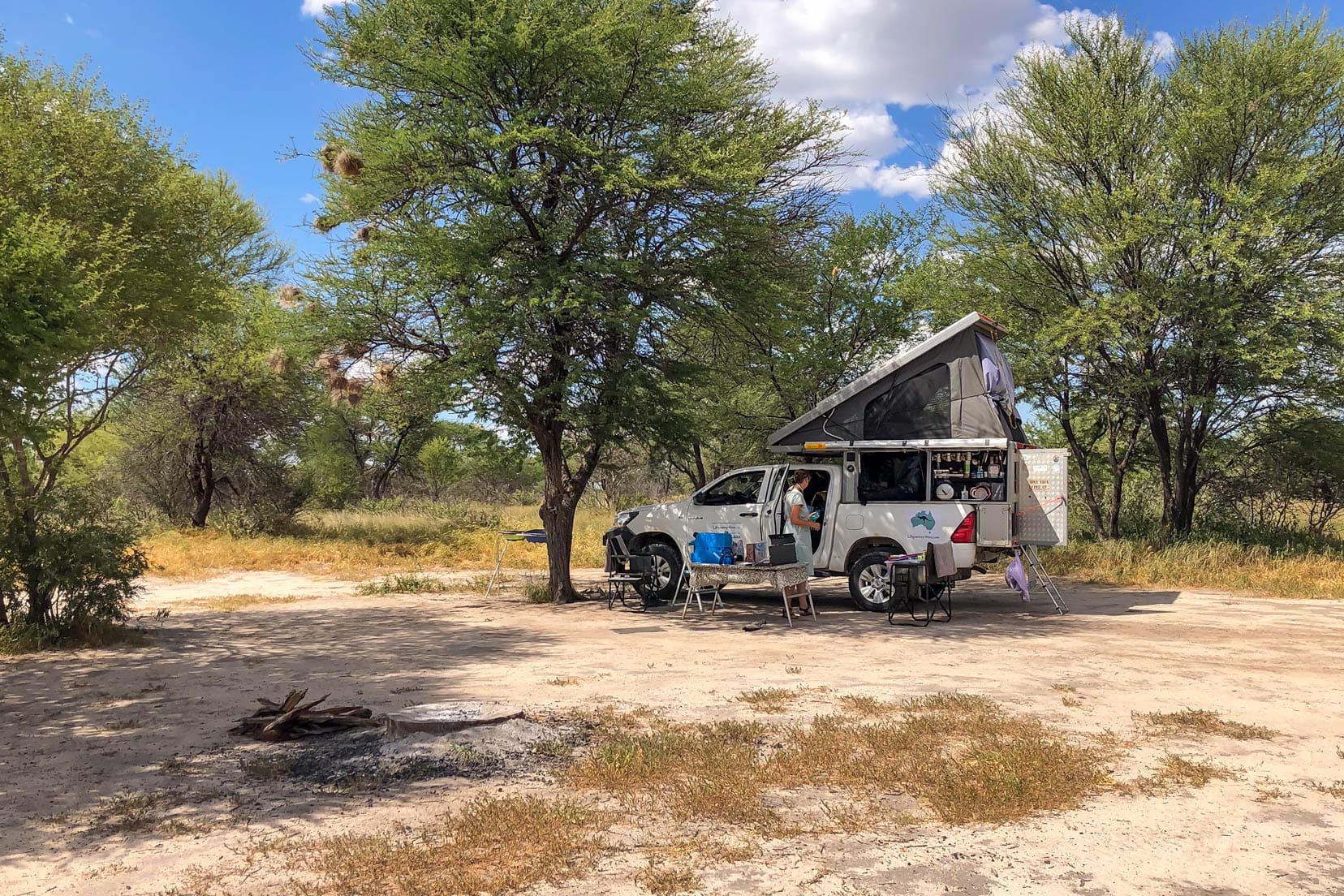
Kgalagadi Transfrontier Park
We had one of our most scary and exciting wildlife encounters while camping in the Kgalagadi Transfrontier Park.
Lions came into camp twice!
The Kgalagadi Transfrontier Park (KTP) occupies the southwestern region of Botswana, extending into the southern parts of South Africa. It represents a groundbreaking collaboration, being Africa’s pioneering Transfrontier peace park.
The KTP was formed in May 2002, combining three parks: Kalahari Gemsbok National Park in South Africa, Gemsbok National Park in Botswana, and Mabuasehube Game Reserve.
The Kgalagadi Park covers an area of 37,000 square kilometres, which is twice the size of Kruger National Park.
Campsites and Facilities
The north-western side of the park (Botswana) includes the following camps around the Pans. Each Pan has between one and four camping spots dotted around it.
Booking a camping trip in the Kgalagadi on the Botswana side can be tricky as private operators and the Department of Wildlife and National Parks (DWNP) manage the campsites. Keep in mind that the process may not be straightforward.
We stayed at Mabua and Mpayathutlwa Campsites, which are the two most popular. Each had a drop toilet, and one had a working cold-water shower. However, watch out for wild animals coming around the wooden shower screen.
- East Gate Campsites — [email protected]
- Lesholoago Campsites — [email protected]
- Mabua Campsites — Inter Tourism Group: [email protected]
- Monamodi Campsites— [email protected]
- Mpayathutlwa Campsites — Inter Tourism Group: [email protected]
- Lefika Campsite (Mpaya Pan) — [email protected]
- Khiding Campsites — [email protected]
- Bosobogola Campsites— [email protected]
Many campsites include an A-frame shade, a fire pit, and a braai grill (BBQ grill). It’s crucial not to assume that there will be water available at every campsite. Thus, it’s advisable to be self-sufficient and always prepared in case the facilities are not functioning correctly.
Wildlife Viewing in Kgalagadi
The park is famous for its unique black-maned Kalahari lions, but it’s also home to other desert animals such as springbok, gemsbok (oryx), and eland.
We’ve marked the Kgalagadi animals that we saw with a green tick.
Likely to see
- Lion ✅
- Springbok ✅
- Gemsbok ✅
- Wildebeest ✅
- Steenbok ✅
- Black-backed jackals ✅
- Kori Bustard ✅
- Secretary bird ✅
- Northern black korhaan ✅
- Ostrich ✅
- Cape ground squirrels ✅
- Yellow Mongoose ✅
- Helmeted Guinea Fowl✅
- Red-billed spurfowl✅
- Spotted hyena✅
If You’re Lucky
- Cheetah ✅
- Leopard
- Wild dogs
- Wild cats
- Honey badger
- Brown hyena
- Giraffe ✅
- Bat-eared foxes ✅
- Red hartebeest
- Eland ✅
- Zebra
- Kudu✅
- Red hartebeest✅
- Lappet-faced Vulture✅
- Slender Mongoose✅
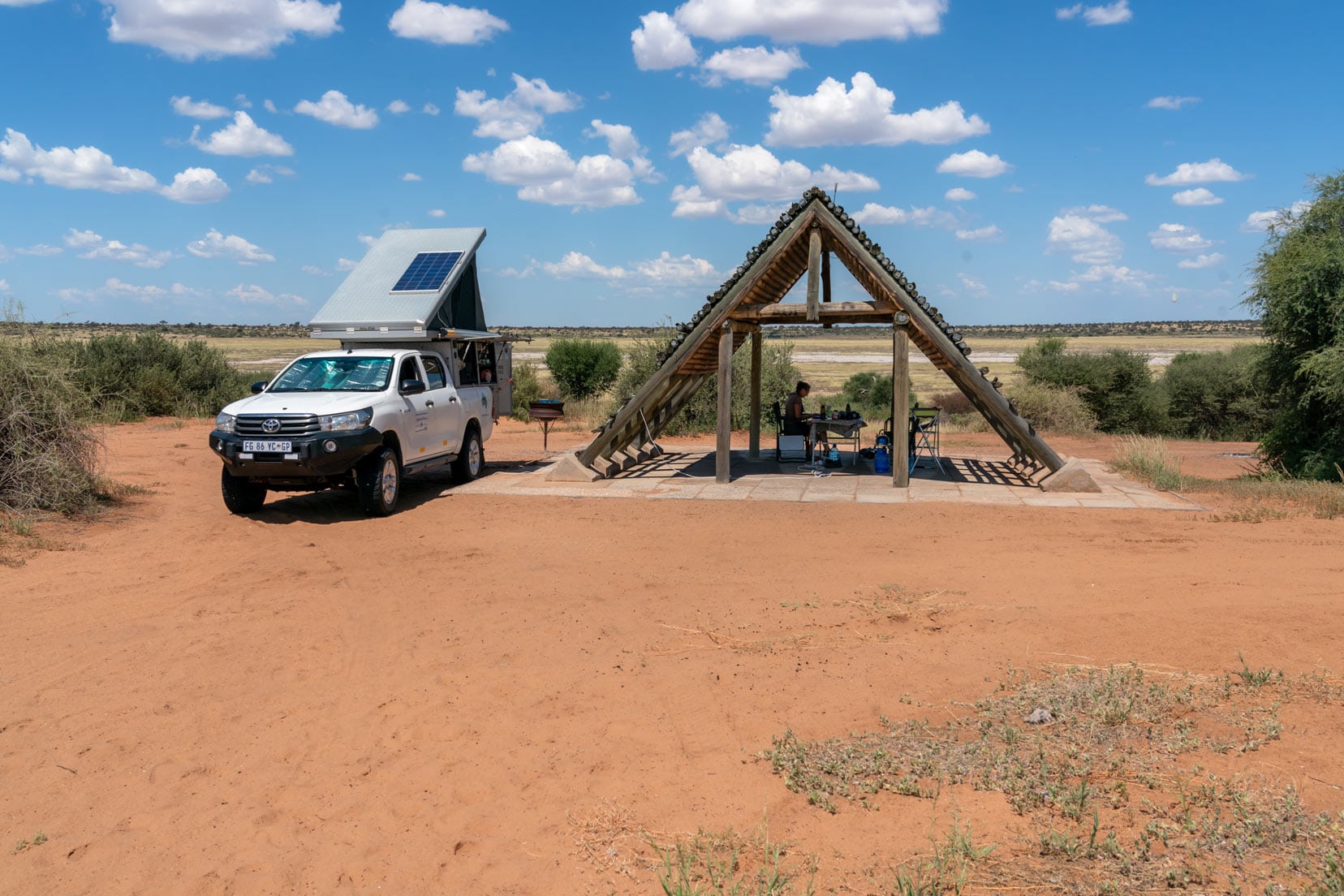
Khama Rhino Sanctuary
In 1989, Seretse Khama Ian Khama, who would later become the 4th President of Botswana in 2008, collaborated with the local community to establish the Khama Rhino Sanctuary with the aim of safeguarding both rhino species.
Spanning over 8.5 hectares of the Kalahari Sandveld, the Khama Rhino Sanctuary has achieved remarkable success, fostering a thriving population of rhinos.
To ensure the rhinos’ protection, the Botswana Defence Force closely guarded the sanctuary, which maintains constant patrols to thwart any potential poaching attempts.
Campsites and Facilities
The Khama Rhino Sanctuary Camp campsites have plenty of space, and all have a large shady Mokongwa tree.
Each camping site also has a firepit, grilled braii, (BBQ) and a water tap, but no power. There are shared ablutions with showers and flush toilets.
Wildlife Viewing in Khama Sanctuary
The green ticks below show the animals we saw while we were camping in Khama Rhino Sanctuary.
Likely to see
- White Rhinos ✅
- Impala ✅
- Springbok ✅
- Steenbok ✅
- Eland ✅
- Kudu
- Oryx
- Red Hartebeest
- Giraffe ✅
- Zebra ✅
- Black-backed jackal ✅
- Blue wildebeest ✅
- Warthog ✅
- Red hartebeest
- Ostrich
- Kori Bustard ✅
- Secretary bird
If You’re Lucky
- Black rhino ✅
- Leopard
- Brown hyena
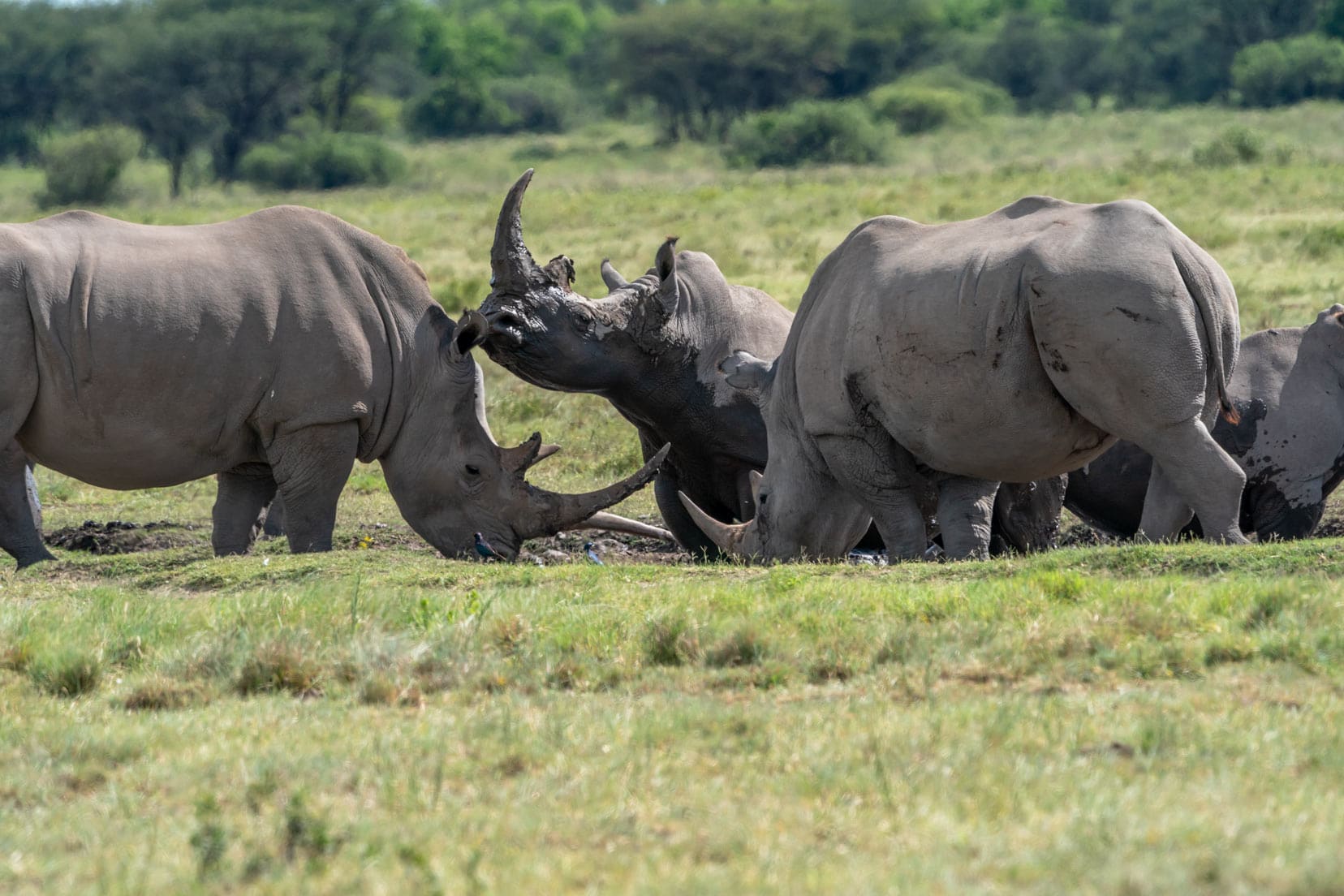
6. Botswana Permits and Regulations
Almost all of the campsites mentioned in this article are in a Botswana National Park or a reserve, and you will need to purchase a permit to enter the park and pay for the number of days that you are in the Park.
This is in addition to any campsite fees you need to pay.
The easiest way to pay your National Park permit fees is beforehand because the Parks and Reserves only take cash at the gate. You can pay by credit card beforehand at any of the Department of Wildlife and National Parks offices (DWNP).
Contact Details for DWNP Offices in Botswana
The general email address is: [email protected]
DWNP Maun: Wildlife Department, Maun, Botswana, Kubu Street (2C8J+82 Maun, Botswana) +267 686 1265
DWNP Kasane: 54CP+MM7, Kasane, Botswana, +267 625 2486
DWNP Gaberone: Moedi House Fairgrounds Gaborone, Botswana, +267 397 1405
You must also show your camping site reservation voucher when entering the parks.
Alternatively, you can use a booking agency. We used Ultimate Routes to book many of our Botswana campsite bookings.
This took an awful lot of hassle out of our road trip planning because getting hold of campsites and coordinating the whole thing from overseas can be tricky.
7. Renting a 4×4 for Camping in Botswana
Most people who are camping in Botswana have 4x4s with tents on top. We have a pop-up tent on our bush camper, and it takes about 20 seconds to pop up the tent.
There are many configurations of camping 4×4 vehicles available to hire, with the majority having rooftop tents. We’ve also seen some overlanders in mini 4×4 motorhome-type vehicles.
🏆 Looking to HIRE a motorhome or camper? We used, and highly recommend, Motorhome Republic — they have an EXCELLENT rating on Trustpilot, and their customer service was amazing.
The type you decide to hire will depend on your preferences and budget. If you will be travelling for any length of time, we’d advise you to get one specifically set up for ease of travel, with good storage options.
We’d recommend getting a quote from the Motorhome Republic as they use some of Botswana’s most popular safari rental companies.
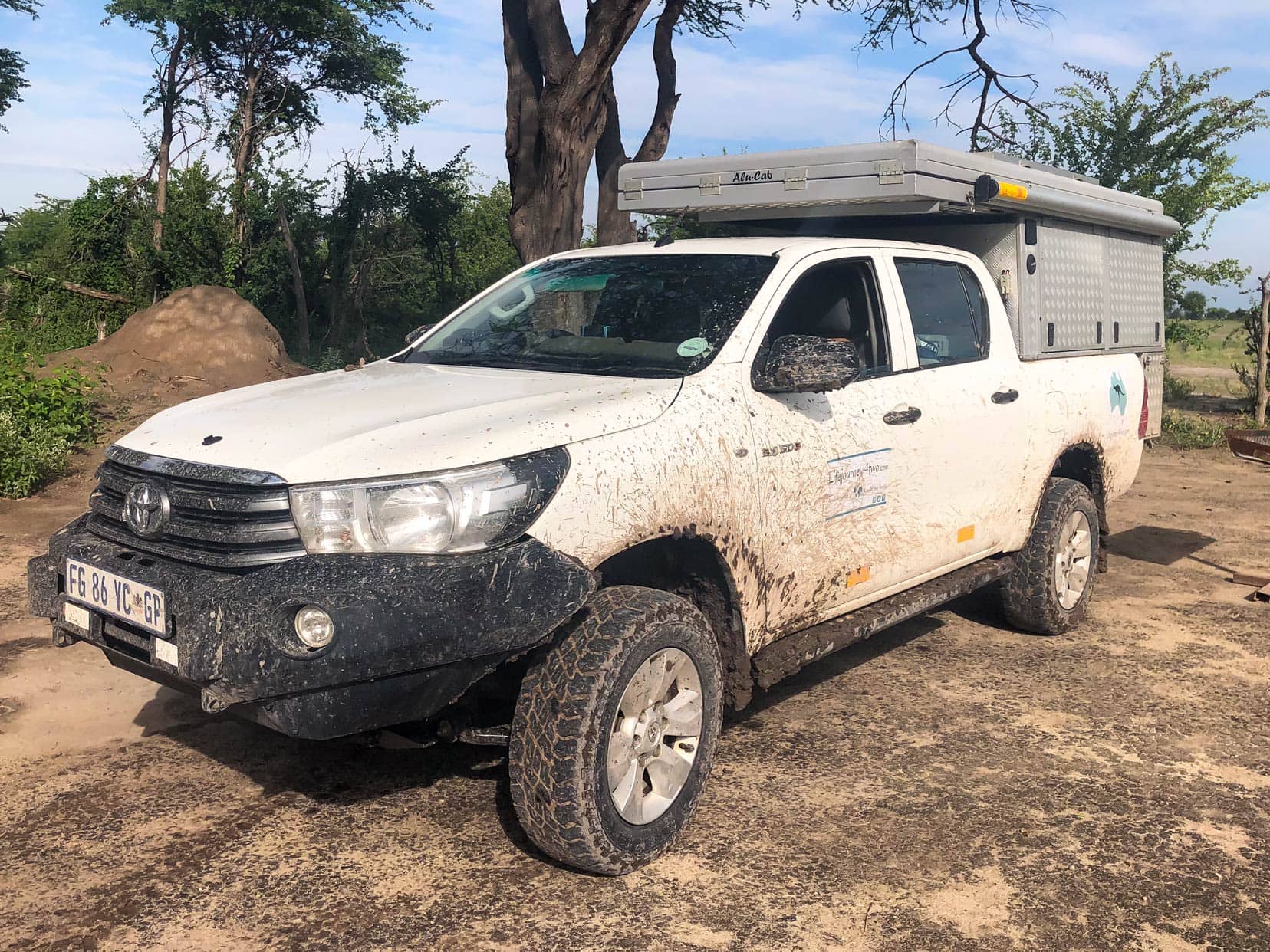
8. Camping Equipment: Essentials for a Botswana Camping Safari
For those seeking an immersive experience with nature, camping with your own tent is an excellent option. Whether you prefer a mobile home or the classic camping approach, a checklist of must-haves is crucial for a successful trip.
Most travellers that we came across who were camping in Botswana were using rooftop tents of some kind. And in Botswana, we’d recommend these rather than ground tents because the National Parks in Botswana are unfenced, and the wildlife does come through camp.
Therefore, we’d recommend a rooftop tent for your safety, and the camping equipment checklist below assumes this is what you have.
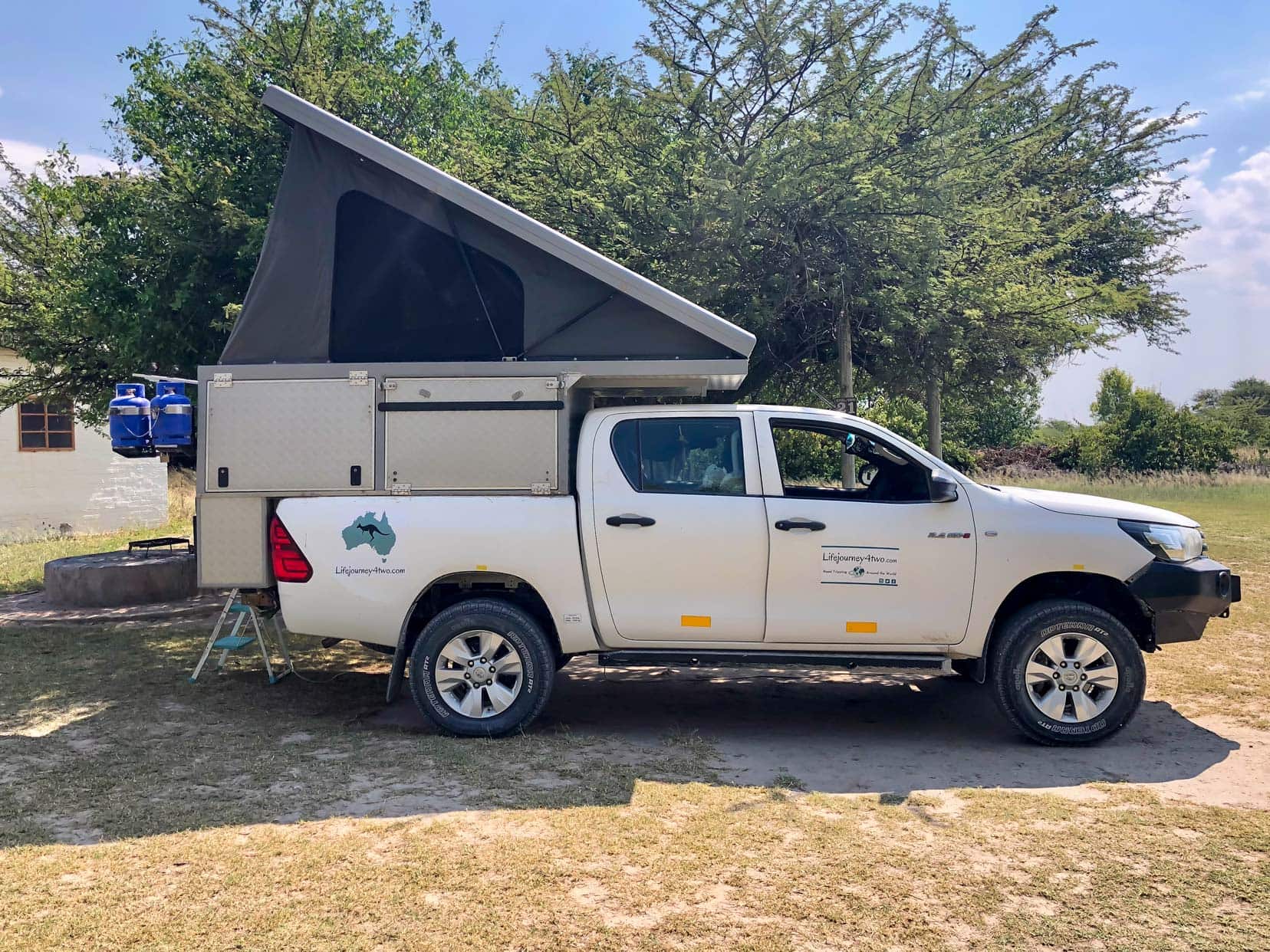
Camping Equipment with a Roof Top Tent
- Roof top tent
- Gazebo with a ground sheet or pull-out shelter
- Sleeping bags, sheets, and pillows
- Folding table and camp chairs
- Spade, hammer and basic tools
- Cooler box or refrigerator
- Water bottles with a filter
- Swiss Army knife or Leatherman
- Dustpan and brush
- LED torch and headlamp
- Toilet paper
For Cooking
- Braai equipment (grid, triangle, tongs, gloves, matches, firelighters)
- Gas cylinder and cooker head
- Saucepan, frying pan, and kettle
- Plates, bowls, cups/mugs
- Cutlery, can opener, chopping board, and knives
- Hand grater
- Paper towels, tinfoil, zip lock bags, and rubbish bags
- Washing-up bowl, dishcloths, scorers, and detergent
Electrical Gear
- 220 V AC extension lead
- Inverter
- Laptop
- External storage device/hard drive for data backup
Maps
- A good paper map and a map app – we use Tracks4Africa products which have been invaluable for us.
⭐️ We rely on the Tracks4Africa self-drive guide in Botswana. It’s never let us down.
Check it out
on Amazon here.
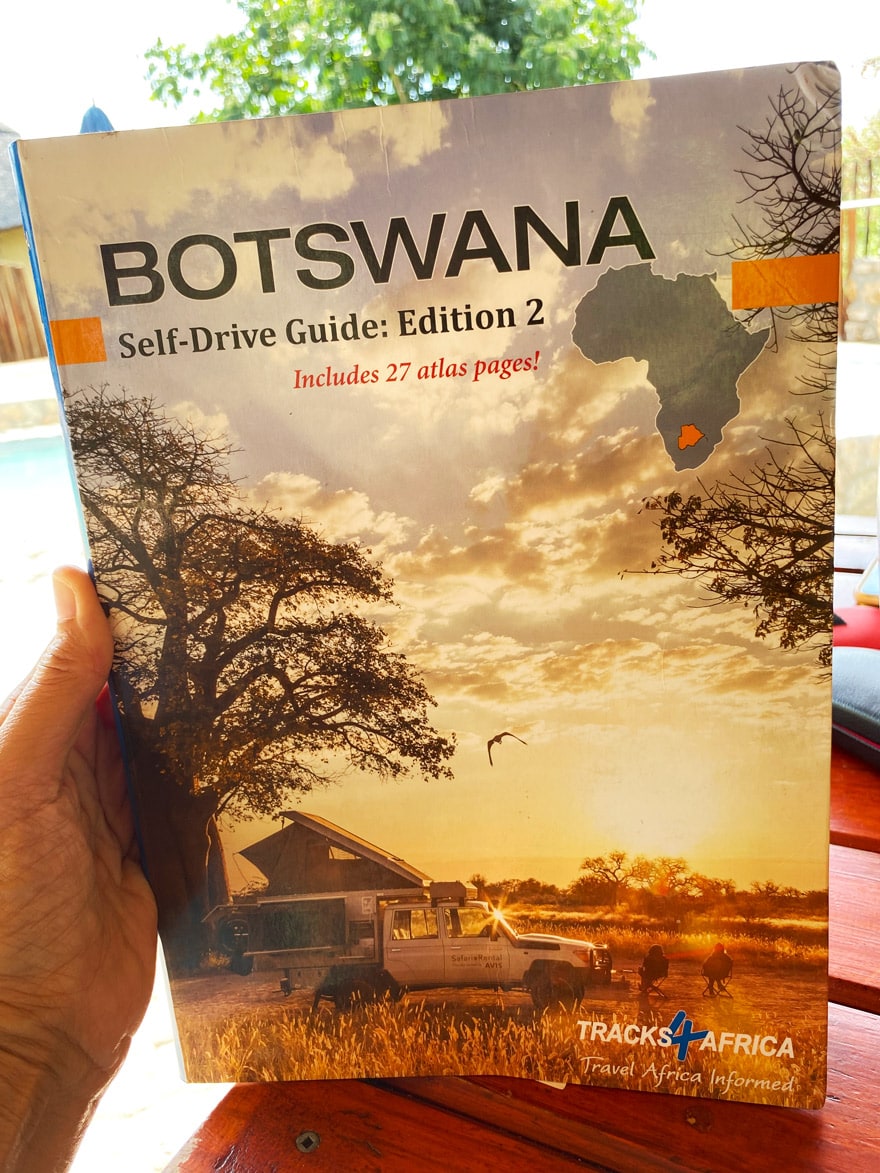
9. Safety Tips For Camping in Botswana
- Stay cautious of approaching wild animals
- Keep tents zipped to prevent unwelcome visitors
- Avoid leaving food out to attract animals
- Avoid having citrus fruit in your vehicle – as this attracts elephants. They have been known to break windows to get to the fruit
- Never sleep with a tent open where wild animals roam
- Avoid getting between a hippo and the water
- Always stay in designated campsites — it is illegal to go wild camping in Botswana
By following this comprehensive checklist and safety tips, you can ensure a memorable and safe Botswana camping safari experience.
💡 TIP: Store Food Securely: Keep all food, trash, and scented items securely stored in lockable containers or vehicles to prevent animal encounters. 🍊Don’t have any citrus fruit stored in your car. Elephants will seek them out 🐘!
10. Best Time to Visit Botswana for Camping
Botswana offers year-round game viewing opportunities, but each season brings its unique advantages and challenges. So, the best time for Botswana safari camping largely depends on your preferences and interests.
Camping in Botswana in the Summer
During the summer wet season from November to April, the landscape transforms into lush greenery, and dramatic thunderstorms create an exciting atmosphere.
We spent many a night snuggled up in the camper, listening to the crashes and booms around us.
The temperatures can be pretty warm during the day — some days reached the high 30s, and while we were camping in the Central Kalahari, temperatures reached 40 degrees. We ended up having to leave a day early because we were going through our water so much.
We were drinking heaps but also needed to use it to wet our cooling towels, which was the only thing we could do to keep cool in the heat of the day.
When you are out in the bush without power, these are invaluable for keeping your core temperatures down.
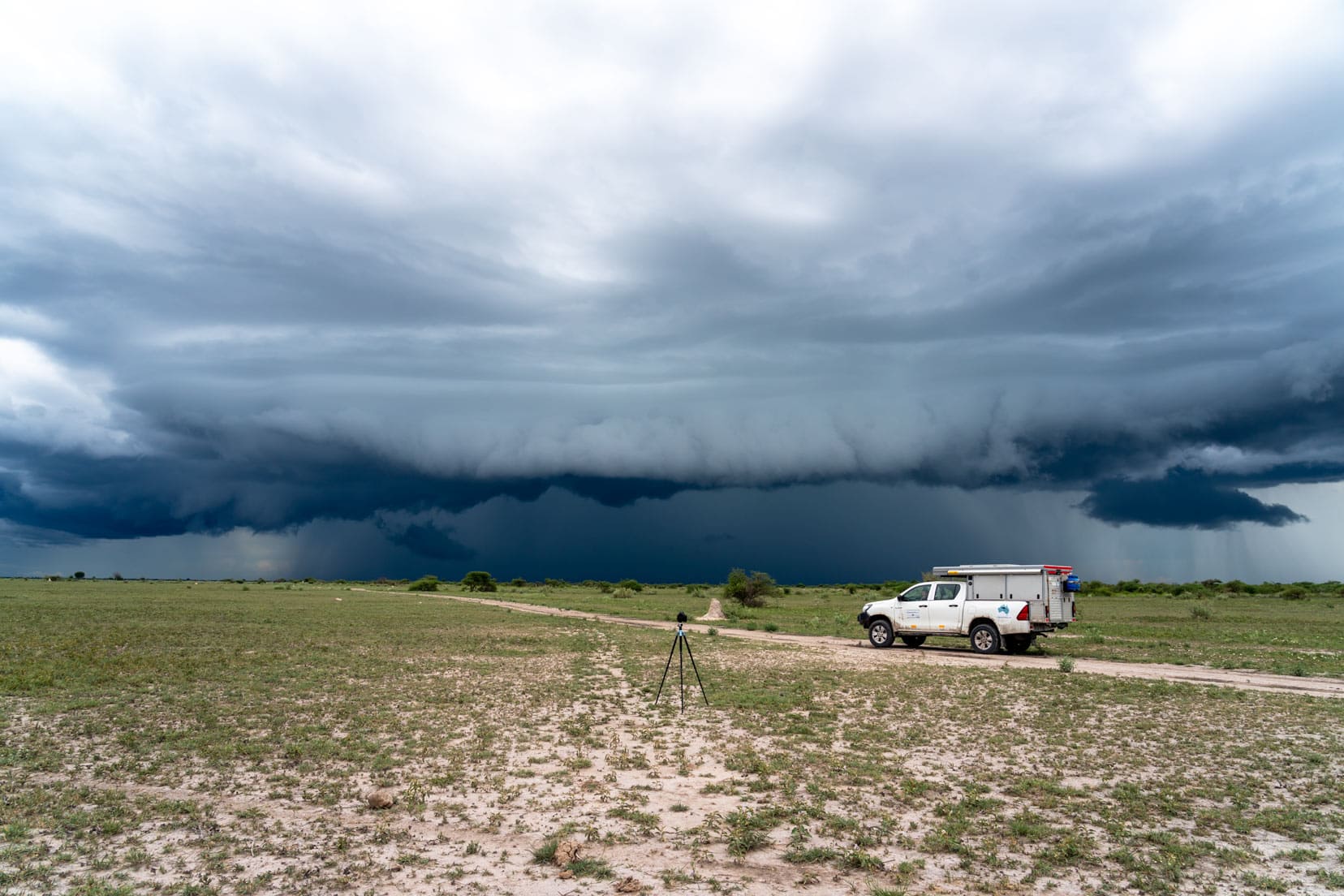
It’s an ideal time for birdwatching as migratory birds flock to the reserve, and the arrival of newborn wildlife adds to the enchanting experience.
However, be prepared for challenging driving conditions, as some reserves are prone to waterlogging. Therefore, vehicle recovery equipment is essential for camping during this season.
The area around the Okavango, particularly Moremi Game Reserve, can be particularly tricky in the rains.
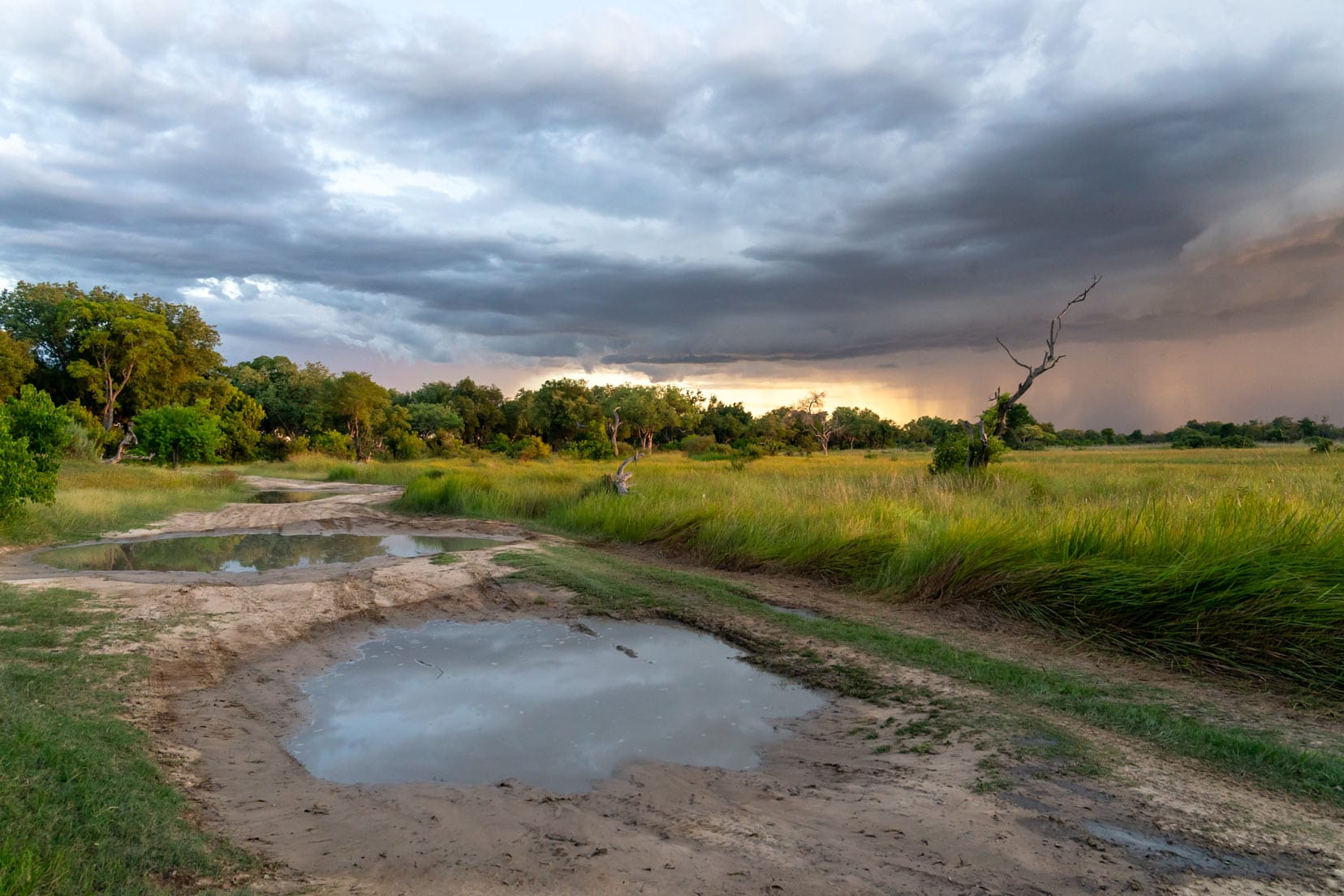
Camping in Botswana in the Winter
On the other hand, the dry season in winter, from May to September, which is the peak camping and safari season, provides a different charm.
The vegetation is less dense, and the tracks are less likely to be waterlogged, allowing for smoother exploration.
The cooler weather adds comfort to your daytime camping experience, but the early mornings and evenings can be chilly. In some of the parks, the nighttime temperatures can dip below freezing, so make sure you pack warm clothes.
Also, keep in mind that campsites are in high demand and may be booked out up to a year in advance. Because it is the peak season for camping in Botswana, popular tracks will get busier with traffic, and you might have to share your wildlife sightings.
If you’re interested in exploring the delta’s waterways, plan your visit between June and August when the Okavango’s water levels are at their highest, enabling captivating mokoro trips and boat cruises.
Do note, though, that there may be a drought in some years, and the Delta doesn’t fill as expected.
Regardless of the season you choose, a Botswana camping trip promises unforgettable moments amidst a breathtaking wilderness.
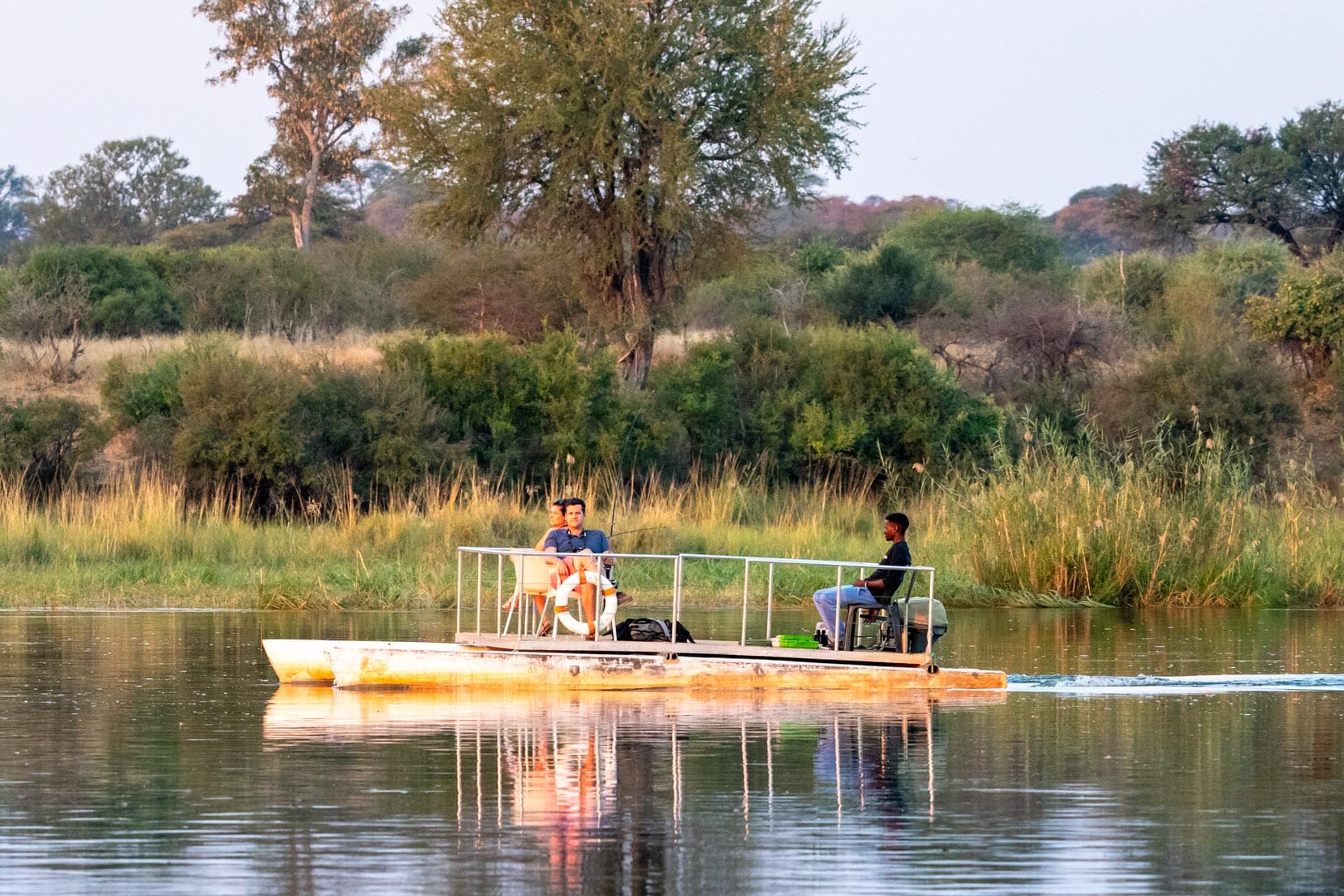
11. Botswana Camping Activities
There are numerous exciting activities for wildlife enthusiasts and nature lovers to enjoy in Botswana.
It’s essential to participate in these activities with a certified guide or through reputable tour operators to ensure safety and minimize environmental impact, as the reserves and parks of Botswana are protected areas dedicated to preserving its rich biodiversity.
Some of the activities available while camping in Botswana include:
1. Game Drives
Not only can you do self-drives throughout Botswana, but you may like to go on a guided game drive.
We would recommend doing at least one guided game drive during your Botswana camping trip. The guides often have inside knowledge of the best spots to find wildlife, and you are likely to see much more than when on your own.
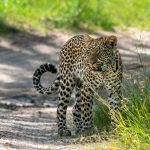
🐆 One day Moremi Game Reserve Guided Safari Drive
From Maun| ⭐️ 5/5 Star Reviews | ⏳12 hours | Book Here
2. Mokoro Excursions
If you are adventurous, you might like to experience the tranquillity of the Okavango Delta on traditional dugout canoes known as mokoros.
It is a popular tourist activity, but we aren’t so keen on it — given that hippos are among the most dangerous safari animals. And they like to hang out in the reeds of waterways!
Mokoro excursions offer a unique and peaceful perspective of the reserve… if you know, there aren’t any hippos around. In fact, it’s one of the most popular day trips from Maun.
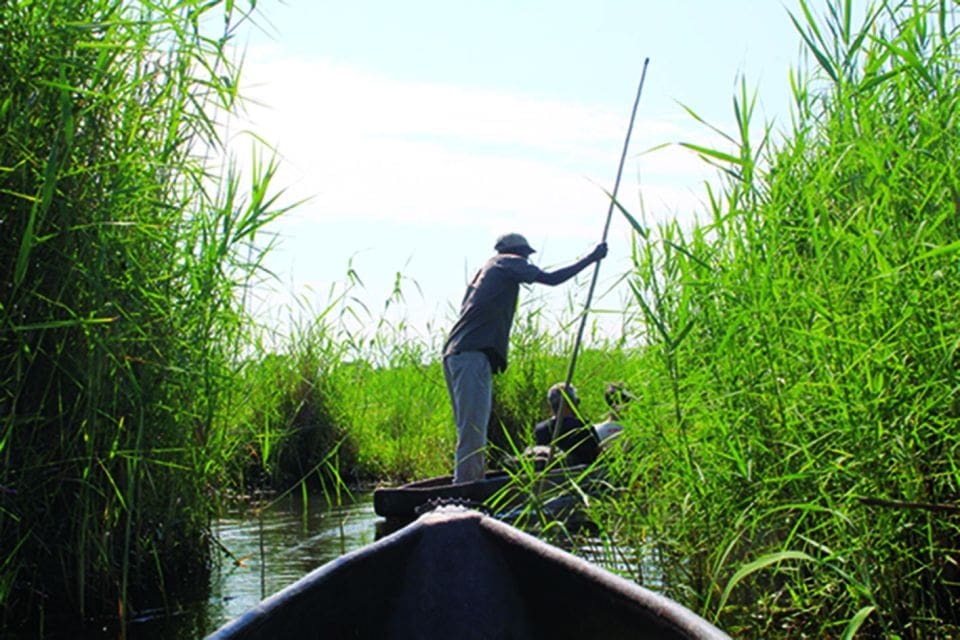
Okavango Delta Mokoro Day Tour (You can also upgrade to a boat tour if you prefer)
From Maun| ⭐️ 4.6/5 Star Reviews | ⏳12 hours | Book Here
3. Birdwatching
Botswana provides a rich habitat for an astonishing array of bird species. Botswana is a birdwatcher’s paradise with over 580 recorded bird species, including colourful bee-eaters, majestic African fish eagles, and rare wattled cranes.
We saw so many varieties of bee-eaters, including the beautiful southern carmine bee-eaters. In fact, we experienced an incredible encounter with them while driving around the Savuti area in Chobe.
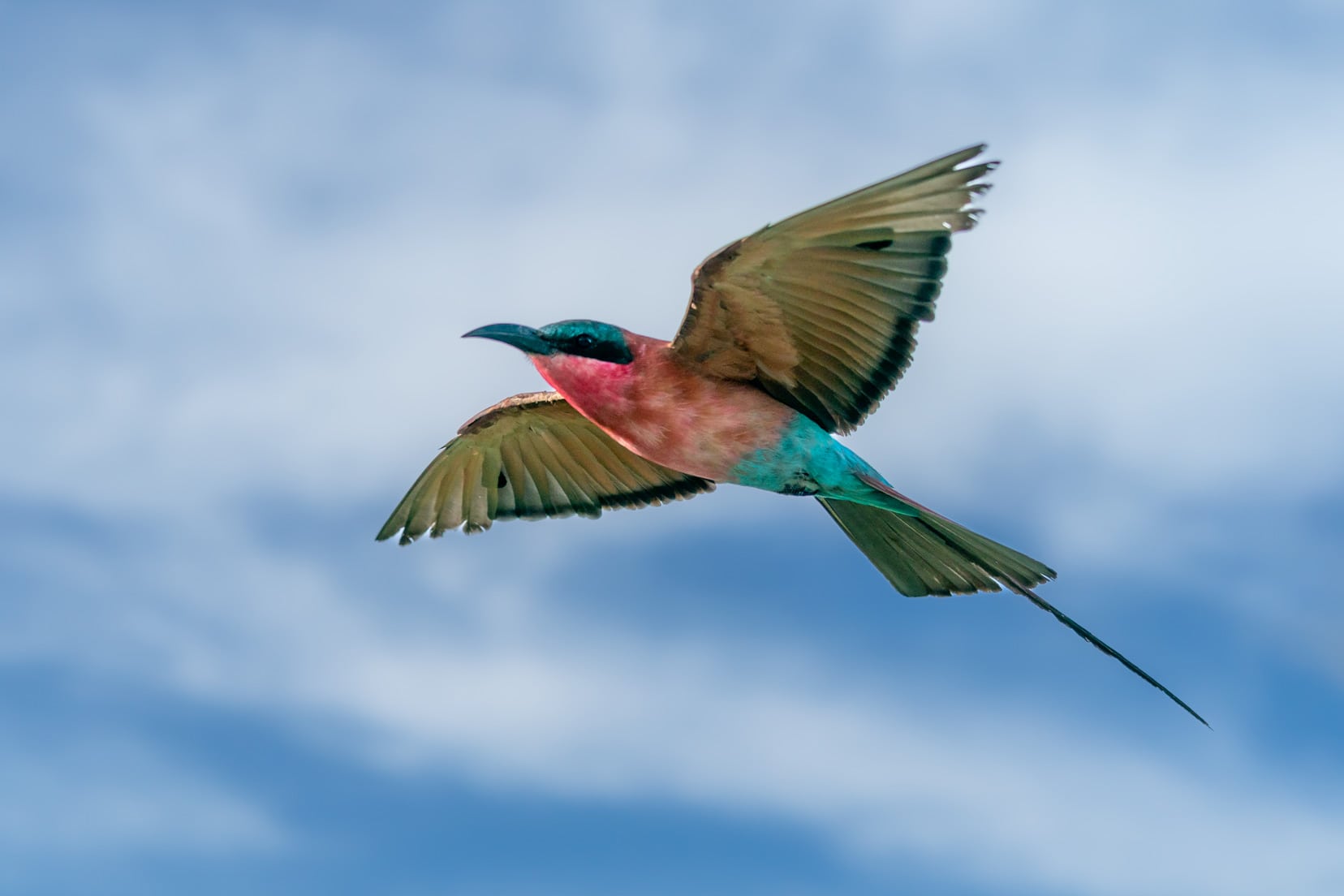
4. Walking Safaris
Accompanied by experienced guides, walking safaris provide an intimate and immersive experience with nature. It’s a fantastic opportunity to explore the smaller details of the ecosystem, learn about the flora and fauna, and track wildlife on foot.
5. Photography
The reserve’s diverse landscapes and abundant wildlife provide excellent opportunities for photography enthusiasts to capture stunning images. Remember to respect wildlife and follow ethical photography practices.
If you are a keen photographer, being able to capture the iconic wildlife of Africa is high on the agenda when camping in Botswana. If you have limited time in Botswana on your camping trip, we’d recommend organising a few guided safari tours because you have a much higher chance of seeing wildlife with a knowledgeable guide and tracker.
If you can afford it, we’d also advise you to book a private guide so you can choose to spend longer at a sighting and control your photographic angles by discussing your needs with your driver. In a group setting, it is harder to do this.
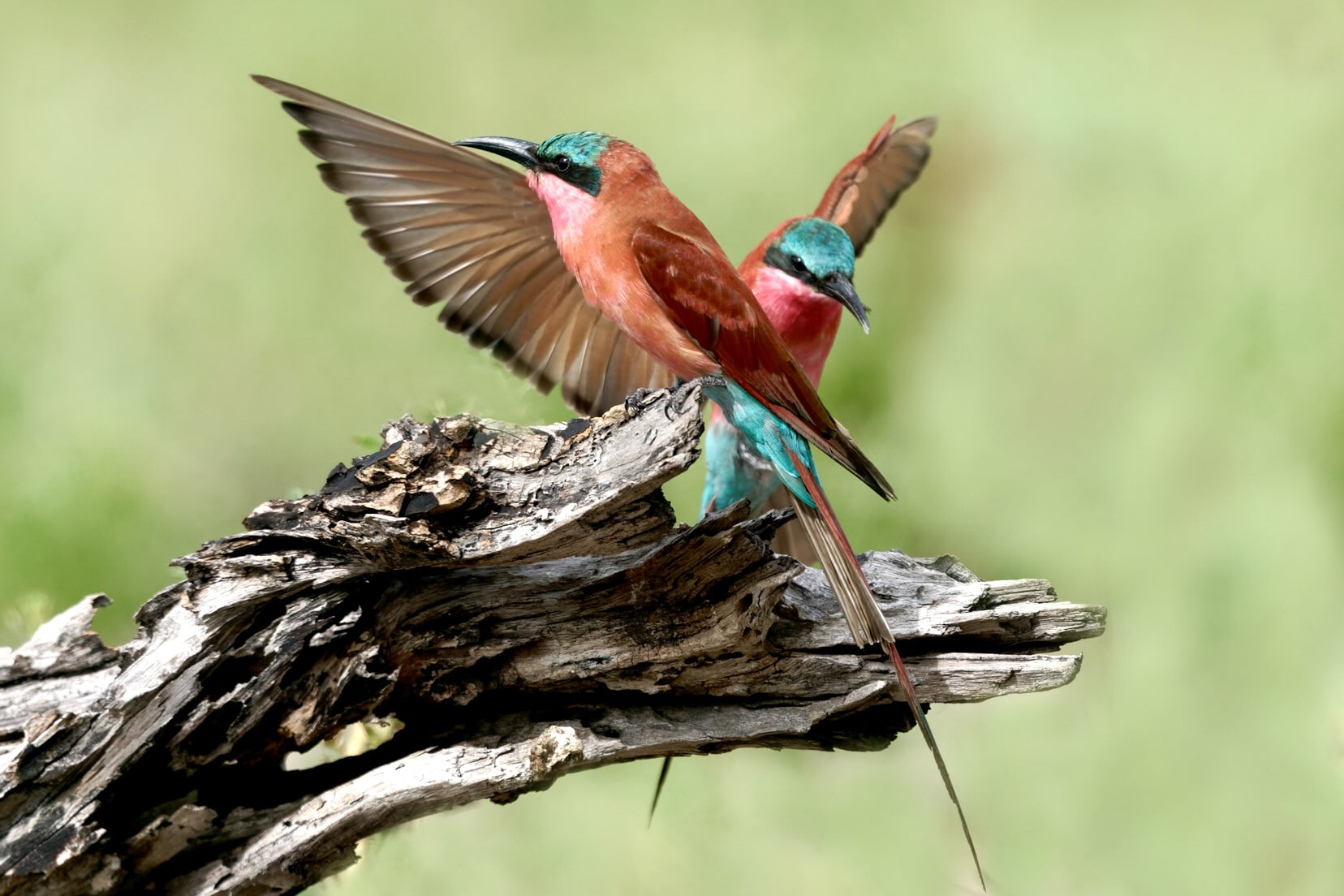
Private Guided Day Safari in Moremi Game Reserve
From Maun| ⭐️ 4.7/5 Star Reviews | ⏳10 hours | Book Here
6. Cultural Visits
Some lodges and tour operators offer cultural visits to nearby villages, providing a chance to interact with local communities, learn about their traditions, and gain insights into their way of life. These include traditional villages like the San (Bushmen) and Batswana communities.
Explore local craft markets where you can find handcrafted items such as pottery, beadwork, woven baskets, and wood carvings, reflecting the country’s artistic talents and cultural heritage.
7. Night Drives
Experience the reserve’s nocturnal wildlife on night drives. Spot elusive predators like leopards and hyenas and fascinating nocturnal creatures such as owls and bush babies.
If you are camping in the reserves, most stipulate that you must be back in camp by sunset. However, if you stay in a lodge for a night or two, you will likely be able to take part in a nighttime safari.
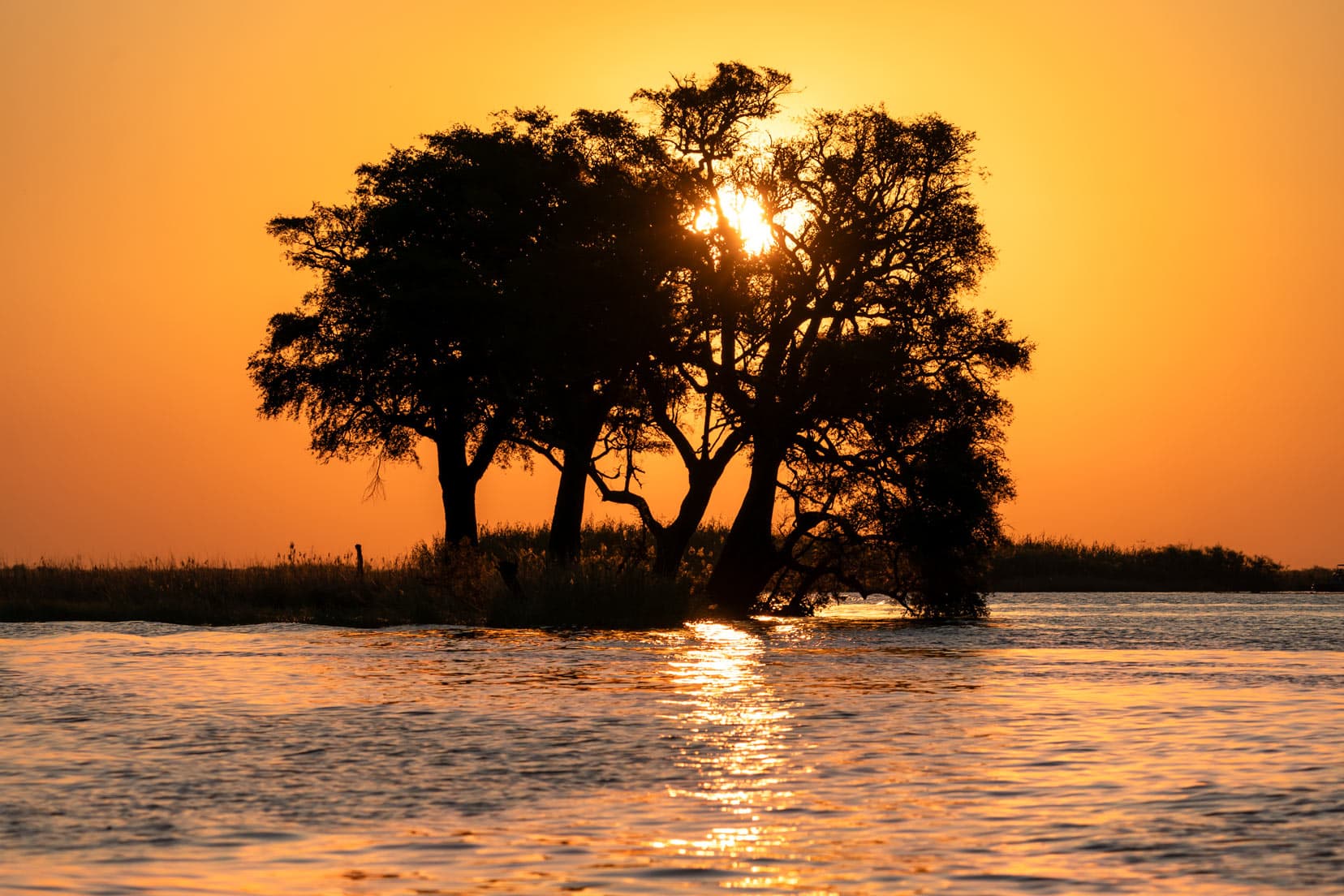
12. Getting to Botswana
The most convenient and popular way to get to Botswana is by air, but if you are camping in southern Africa, you may be crossing at one of the many borders from neighbouring countries.
Getting to Botswana by Air
Botswana has several international airports, the most significant being Sir Seretse Khama International Airport (GBE) in the capital city, Gaborone. Other airports with international connections include Maun International Airport (MUB) and Kasane International Airport (BBK).
By landing in Maun, you will be at the ‘Gateway to the Okavango’, a popular base for campers overlanding in Botswana.
If you fly in and need to pick up a hire camper or car, we recommend staying in a hotel or B&B before setting off on your camping adventure. That way, you have time to recoup after flights.
We have stayed in several different places in Maun and recommend the following:
- 🏆 Overall #1 Guesthouse in Maun – Maun Studios
- 💎 Best Luxury Accommodation – Boteti Safari Camp
- 🏨 Best Hotel – Maun Lodge
- ⭐️ Best Self-catering accommodation – Acacia Cottage
- ⛺️ Best Budget Chalet and Camping – Sitatunga Camp
- 👨👩👧👦 Best for a Family – Villa 13 Maun
Getting to Botswana By Car / Camper
If you are travelling from neighbouring countries, you can enter Botswana via land borders.
Self-driving is a popular option; however, be sure to research the specific border-crossing requirements and have all the necessary documents for your vehicle or rental car.
Remember that visa requirements and entry regulations may vary depending on your nationality. Check with your country’s Botswana embassy or consulate to ensure you have all the necessary travel documents before your trip.
🚐 Bush Camper Hire in Botswana
We recommend using Motorhome Republic to find you the best deal – they search reputable African rental companies, including Avis Safari, Britz and Caprivi Car Hire.
They do all the hard work for you and are available 24/7.
13. FAQs About Camping in Botswana
1. What are some popular campsites in Botswana?
Botswana offers a variety of campsites where you can enjoy incredible landscapes and wildlife. Some popular options include Moremi Game Reserve, Chobe National Park, Central Kalahari Game Reserve, and the Kgalagadi Transfrontier Park.
2. Can I go camping in Botswana without a tour operator?
Yes, you can definitely go on a self-drive safari and organize your camping trip without a tour operator. There are many overlanders doing just that, and it’s becoming a popular option in Botswana.
3. What should I know before camping in Botswana?
Before embarking on your camping adventure in Botswana, it’s important to be aware of the seasons. The dry season in winter is the peak time for camping. It’s also crucial to familiarize yourself with the rules and regulations of the national parks and game reserves to ensure a safe and enjoyable experience.
4. Are wild animals a concern while camping in Botswana?
Yes, when camping in the wilderness of Botswana, you may encounter wild animals such as elephants, lions, and hyenas. It’s essential to follow safety precautions, such as storing food properly and keeping a safe distance from wildlife.
5. What are the best safari options for camping in Botswana?
Botswana offers a wide range of safari experiences. Some of the best options include a camping safari in Botswana, where you can stay in designated campsites within national parks, or a mobile safari, where a professional guide accompanies you on your journey.
6. Where can I go wild camping in Botswana?
It depends on what you mean by wild camping. It is illegal to wild camp anywhere other than in designated camping spots. However, many of Botswana’s camps are remote and in the wilderness.
7. What are some must-visit national parks and game reserves in Botswana?
The must-visit game reserves and parks in Botswana are Moremi Game Reserve and Chobe National Park. There are plenty of others, but these two are the most popular for their large diversity of wildlife.
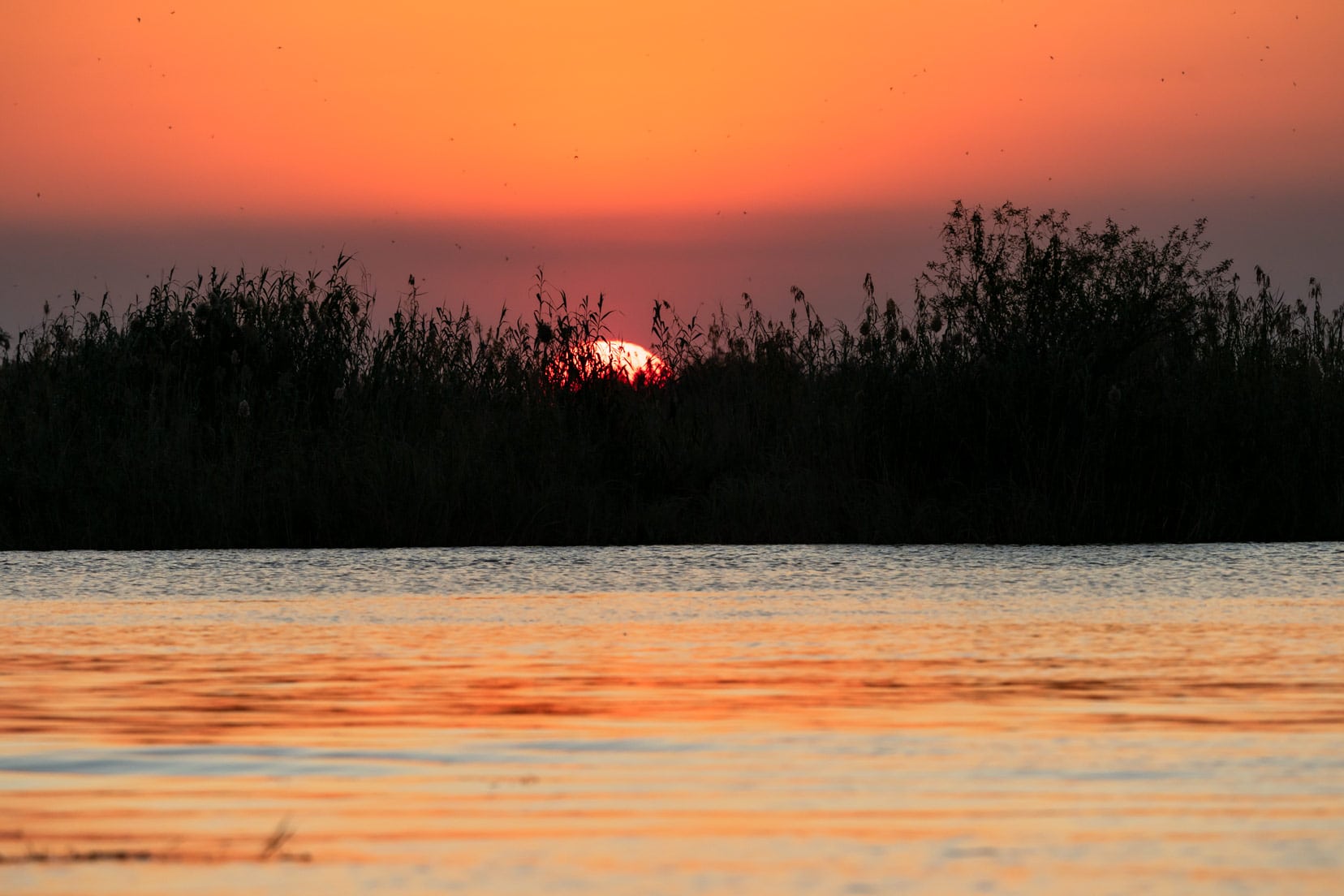
Camping in Botswana … That’s a Wrap
Botswana offers an amazing camping experience. From the iconic Okavango Delta to the majestic Chobe National Park, there is no shortage of breathtaking experiences.
In Botswana, camping isn’t just a recreational activity – it’s an opportunity to connect with nature and immerse yourself in the wonders of the African wilderness.
Imagine waking up to the roars of majestic lions in the distance, surrounded by the raw beauty of nature, and spending your days exploring vast national parks with its iconic African animals. Sounds like a dream come true, right?
So grab your sense of adventure, start planning and get ready to discover the magic of camping in Botswana.
Pin and save for later
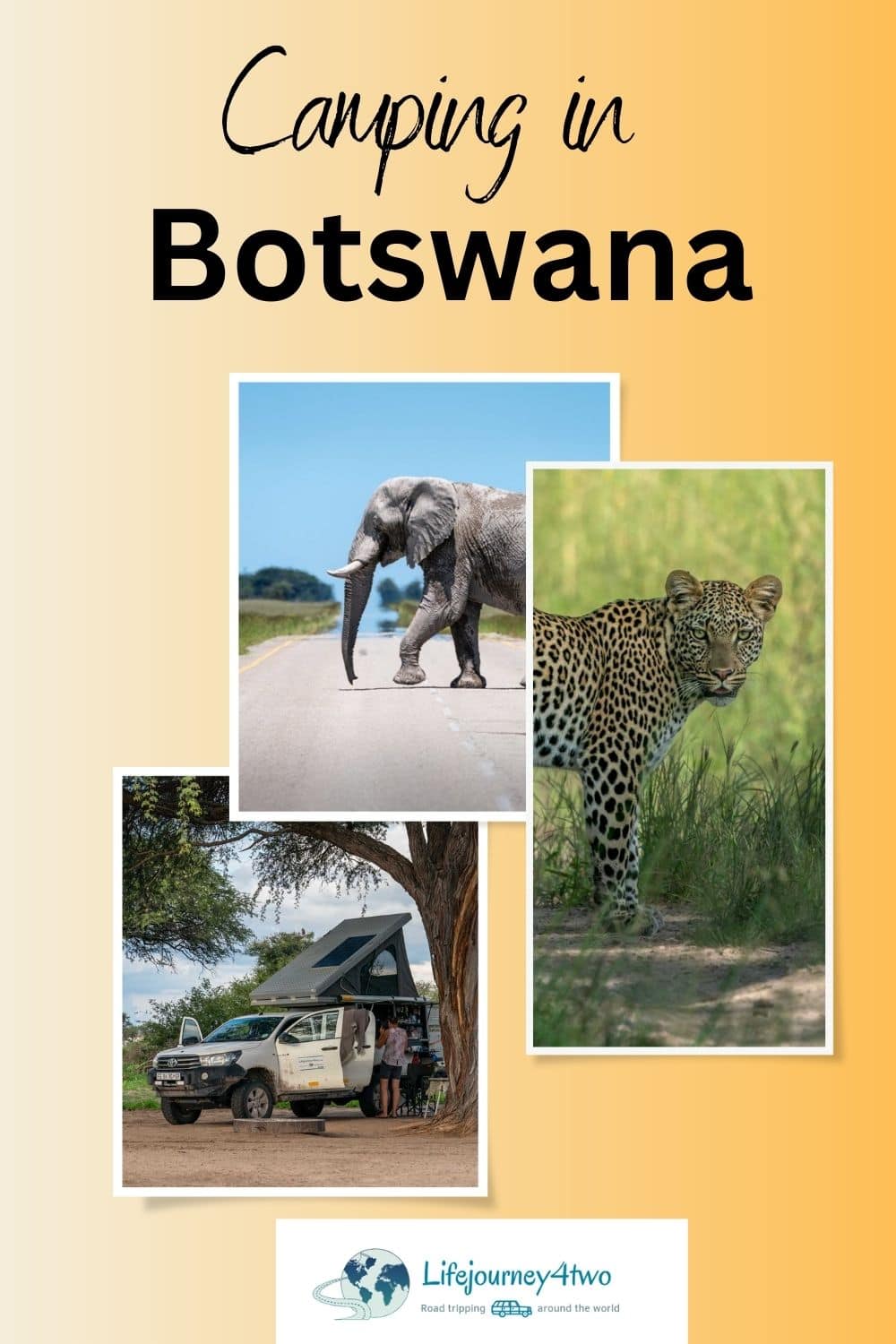
You May Also Like to Read:
Planning Your Travels?
These are the travel resources we recommend and use when planning our trips.
- 🚘 Car Hire: We use DiscoverCars.com
- Motorhome/Campervan Rental: We highly recommend the Motorhome Republic
- 🪪 Order your International Driver’s Licence online here
- 🛏 Book Accommodation: We use Booking.com to find accommodation that suits our budget
- 🐶 Pet Sitting/Pet Sitters: Check Out TrustedHousesitters here (Use our Discount code: LIFEJOURNEY25 for 25% off. )
- Activities and Experiences: Get Your Guide and Viator
- Travel Insurance: Safetywing or World Nomads
- 🥾 Travel Gear and Accessories: Check out our top picks here — Lifejourney4two page on Amazon
For a more thorough list, visit our Travel Resources page here.

